Meet the inspiring young professionals energizing
New York City Page 13







Meet the inspiring young professionals energizing
New York City Page 13






No matter who wins, electoral concerns in uenced congestion pricing, housing, tax decisions
By Nick Garber
e country will be watching elsewhere for battleground presidential results on election day, but New York’s six swing-district congressional races put the Empire State suburbs at the center of the ght for control of the U.S. House of Representatives.
If Democrats prevail, it would be the rst time New York has seated a Speaker of the House since 1869. But it’s no sure


thing: Republicans gained four seats in traditionally deep-blue New York in 2022, eking out a slim House majority for the party, and putting state Democrats in an unfamiliar position.
Gov. Kathy Hochul has arguably done everything she could to avoid a repeat in this week’s elections, favoring policies that aim to strengthen suburban Democrats: e governor paused congestion pricing and dropped her pursuit of wide-ranging housing reforms. e choice state lawmak-
ers made last year to exempt suburbs from a tax hike on employers that will fund the Metropolitan Transportation Authority — even though those areas bene t from the MTA’s services — also appeared designed to placate voters in these suburban House districts.
“It’s strengthened the suburbs’ hand, vis-a-vis the city,” said Kathryn Wylde, president of the business group

POLITICS & POLICY
New York begins implementing curbs of the future pilot program in Manhattan
3

CRAIN’S LISTS
The largest nonpro ts and largest foundations in the New York area
By Jack Grieve
Artificial intelligence was not born in New York, but as the technology proliferates across industries, the city is uniquely positioned to be the place it finds real business applications.
That was one of the themes discussed at the Crain’s New York Tech Summit, hosted Oct. 29 at the Accenture Innovation Hub in partnership with nonprofit Tech:NYC, where a dozen local tech leaders shared their thoughts about AI implementation, regulation and education.
They spoke of a city primed to guide the biggest technological innovation since the internet into the daily workplace operations of nearly every industry.
Laura Peterson, senior managing director at Accenture, said New York’s role in the augmentation of AI is mushrooming as the technology moves into the socalled “imagination phase,” or the period in which businesses can shape AI to fit their work needs.
“When we think about the use cases and the imagination of what’s possible (for AI), you have to have the business (people) and the technology (people) equally at the table,” she said.
That kind of collaboration can only happen here because this is where tech and business coexist, said New York City Economic De-

14
NETWORKING WITH REAL ESTATE
Join us for networking, dealmaking, and a live interview with Carlo A. Scissura, President & CEO of the New York Building Congress. He’ll talk with Crain’s New York Editor-in-Chief Cory Schouten about big developments on the horizon for New York City, an evolving economic picture for the construction industry, the city’s readiness for climate change, and the regulatory environment including Local Law 97.
DETAILS
velopment Corp. President and CEO Andrew Kimball.
“New York City has already emerged as the global hub for applied AI. Why is that? Because we have a diversified economy,” he said, explaining that New York is where AI can seep beyond the Silicon Valley bubble and into other sectors of the economy because of that diversity.
“A lot of the invention around large language models, that is coming out of (Silicon Valley) and that is probably going to primarily remain in (Silicon Valley),” Kimball added. “There is some of that engineering work that is happening in New York City and it is growing, but overwhelming what we are going to be is the global capital of applied AI — how you take that new tool and apply it across every industry.”
New York is particularly important for businesses applying AI because the city is “where the financial institutions that help power the world come together,” said Julie Samuels, founder and president of Tech:NYC. She described the city as “the responsible and leading innovator in AI.”
In an interview with Crain’s ahead of the event, Samuels said New York’s AI future is promising because “once you think about the

application of these new AI tools — who is going to use it everyday, for what and in what context, how much they are going to pay for it and how are they going to access it — those questions tend to get answered here in New York.”
Also at the Tech Summit was a representative from Governor Kathy Hochul’s office who made the case that the public sector is doing its part to make the state a hotbed for applied AI activity.
“The governor has made clear she wants to make New York the capital of responsible AI,” said Albert Pulido, the state’s deputy secretary for finance and technology.
“If AI is a tool that can truly solve real world problems faster and better than we could ever envision, then it’s our responsibility to explore that as a government.”
Pulido added that the state “needs to be responsible in understanding the needs of the workforce” as it relates to AI. He echoed the sentiment that New York will have an outsized role in AI adaptations across the economy because the state is a leader in so many industries. “What we do here, other states are going to follow,” he said. Applied AI was not the only theme of the event. The need for training all New Yorkers in how to
use the powers of artificial intelligence was also a key topic. “New York can be a beacon” for ensuring equitable access to this technology, said Tarika Barrett, CEO of Girls Who Code. “We cannot afford here in New York City to create an underclass of folks who are not in on this movement of emerging technology. We have to make sure we do not leave an ounce of talent on the table, and that we are investing in young people as we are thinking about any new technology we are going to bring to market.”
And the discussion at times went beyond AI altogether. Frank Reig, the CEO and co-founder of Revel, for example, gave a full-throated endorsement of congestion pricing during his fireside chat with Crain’s editor-in-chief Cory Schouten. He spoke about being a big supporter of open streets and said the city should close 10% of them across the five boroughs to cars and trucks to make them more pedestrian friendly. Reig reiterated his company’s plans to expand the city’s publicly accessible electric vehicle fast-charging infrastructure, with new ones recently open in Bedford-Stuyvesant, Long Island City and Pier 36 in Manhattan. Another hub is slated soon for LaGuardia Airport and Reig hinted at a possible expansion at JFK as well.
Crain’s reporter Julianne Cuba contributed.
By Eddie Small
New York City Economic Development Corp. President and CEO
Andrew Kimball revealed new details Oct. 29 about the city’s plan for a “blue highway” to help ship
The NYCEDC head said giant companies like Prologis and Amazon are now showing more interest in shipping goods via waterways.
goods via waterways throughout the city, saying that logistics giants like Prologis, Amazon and UPS are now extremely interested in the idea.
“The cost of having their trucks stuck in traffic, stuck on bridges, paying tolls, getting yelled at: No más,” he said. “They want to see if it actually works financially to start to move those goods by water.”
Kimball made his remarks Oct.
29 at the Crain’s New York Tech Summit, hosted at the Accenture Innovation Hub in Hudson Yards’ 1 Manhattan West. The interview with Cory Schouten, Crain’s editor-in-chief, also touched on subjects including Kimball’s strong support for the Adams administration’s City of Yes housing reforms. Kimball said the lack of housing is the biggest challenge facing economic development in the city today.
The NYCEDC and the city’s Department of Transportation announced in November 2023 that they were putting out a request for information and expressions of interest about ways to move goods through waterways rather than roadways. The request aimed to get feedback from private companies on the challenges and opportunities in the idea and help the city determine how feasible it would be to launch a marine freight pilot program.
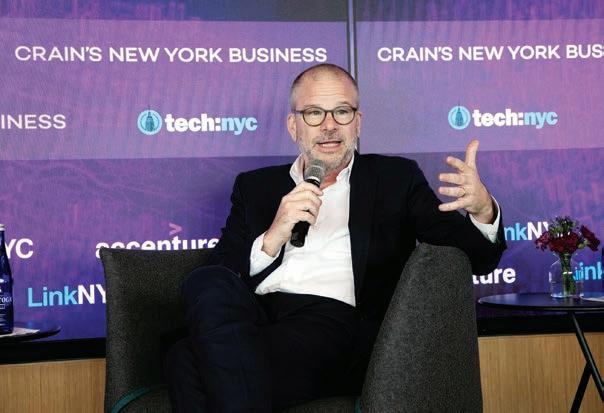
Kimball described the Brooklyn Marine Terminal in Red Hook as a major pivot point for the plan. The city just recently gained control of the terminal from the Port Authority of New York and New Jersey, something mayoral administrations had been trying to do for 40 years, Kimball said.
“The Brooklyn Marine Terminal would be one node of many around the city — including our 25 ferry landings, including Pier 92 on the West Side, including Hunts
Point up in the Bronx — where goods can move by fast boat or barge going into the future,” he said.
He acknowledged that this project would require a lot of federal assistance but said obtaining such funds has not been a major problem as of late.
“There is more money flowing than in my lifetime from the federal government for things that I suspect 99.9% of people in this room care about,” he said.

The Upper West Side is in for more metered parking, loading zones, bike corrals in hopes of improving congestion
By Nick Garber
After more than a year of planning and outreach, the city will start implementing a pilot program redesigning dozens of curbs on the Upper West Side in hopes of improving congestion and reducing conflicts between pedestrians, cyclists, drivers and delivery trucks.
The Smart Curbs pilot is now underway between West 72nd and 86th streets, bounded by Broadway and Central Park West, where the first phase of implementation will last through the end of the year, according to an announcement shared with Crain’s. The most notable changes include
The first phase also entails installing 30 new bike corrals and a public space with benches and planters in the curb lane of Columbus Avenue near West 72nd Street, added with the support of the Columbus Avenue Business Improvement District.
As a result, some 100 parking spaces that are currently free will become metered during the day for commercial vehicles, Department of Transportation spokeswoman Mona Bruno said. And, the city hopes, local streets will become safer and less chaotic.
“New York is on the cutting edge of rethinking the curb, one of cities’ most valuable assets. Everyone wants a piece of our precious sidewalk and curb lane,” said Meera Joshi, the deputy mayor for operations, in a statement. “With the Smart Curbs program, we are prioritizing uses based on community needs, not just first-come, first-serve.”
“New York is on the cutting edge of rethinking the curb, one of cities’ most valuable assets. Everyone wants a piece of our precious sidewalk and curb lane.”
Meera Joshi, deputy mayor
for Operations
the creation of six new truck loading zones where passenger parking will be barred during daytime hours, and 21 neighborhood loading zones reserved for either commercial or passenger cars that are actively unloading or loading — including taxi pick-ups and drop-offs.
The city is not committing to expanding the program to any particular areas, but Bruno said the department will take a similar approach to study the curb needs of other neighborhoods and commercial corridors.
As part of the changes, DOT will also remove a rush-hour rule that restricted parking along the west side of Columbus Avenue on weekday mornings. That lane had grown so in-demand — and lately filled up with

outdoor dining structures — that it rarely functioned as intended as a travel lane, and the new change will legalize parking, loading and drop-offs.
A second phase of implementation, starting in 2025, will entail creating curbside “hubs” for electric-vehicle charging and local deliveries. The aim is to provide a place for parcels to be transferred for their last leg of delivery — from trucks onto bikes or handcarts.
Another 80 free parking spaces will become metered for passenger vehicles during the second phase, although DOT is quick to note that the project will affect only a small fraction of the 2,500 total parking spots on the Upper West Side. City officials said they chose the Upper West Side as the guinea pig because of the neighborhood’s density, low rate of car ownership and rising demand for a variety of different curb uses.
The celebrity photographer Annie Leibovitz sold the 495 West St. space at a profit for $8 million
By C. J. Hughes
Photographer Annie Leibovitz seems to have had a good eye for a downtown real estate investment.
The chronicler of the powerful and famous for magazines such as Vanity Fair has sold her studio at 495 West St. in the West Village for $8 million, according to a deed that appeared in the city register Oct. 29.
Leibovitz paid $6.5 million for the 3,200-square-foot atelier just two years ago, the register shows.
Technically a two-bedroom apartment, though styled with an open floor plan that gives it more of a workplace look, the fifth-floor condo unit sold rather quickly, going into contract in March after only two months of marketing and without any discounts, records show.
In contrast, Manhattan’s luxury market, or the top 10% of sales, saw apartments sit on the market for an average of nearly four months before going in contract in the third quarter, based on sales data prepared for the brokerage Douglas Elliman by the appraisal firm Miller Samuel.
And the median price of those high-end deals was $5.8 million, which was down 4% in a year, according to the data.
The buyer in the transaction, which closed Oct. 18, shielded themselves with a shell company, TSN West Street LLC, which has an address of a house in Sheepshead Bay, Brooklyn. But the buyer section of the deed also bears the signature of Wan Hung Cheng, whose connection to the shell company wasn't immediately clear.
Located in an 11-story, 9-unit building between Jane and West 12th streets, Leibovitz’s studio is a column-lined unit with a fireplace, heated bluestone floors and sweeping Hudson River views. The occupation of its past owner is barely disguised, suggesting its marketers leaned into the property’s celebrity cachet to help offload it.
Photos hang from a board, while a printer the size of a casket dominates a countertop. Plus a listing picture of the “artist’s photography studio,” as its ad puts it, features a book with Leibovitz’s name on the spine angled cheekily toward the camera.
Leibovitz, who has produced memorable portraits of actress Demi Moore, former Sen. Hillary Clinton and musician John Lennon, has seemed to be in a selling mood as of late. In February she closed on the sale of her four-bedroom duplex at 88 Central Park West for $10.6 million after paying

$11.3 million for the co-op in 2014. But like her studio, the home sold swiftly, just a few months after hitting the market.
A prolific investor in city real estate through the years, Leibovitz once owned a veritable compound in the West Village made up of three side-by-side townhouses at West 11th Street and Greenwich Street. But debt problems that came to a head in the Great Recession, including a lawsuit from a creditor in connection with a $24 million loan, appear to have pushed her to scale back her New York footprint.
In 2013 Leibovitz unloaded the entire Village spread to the fashion

executives David Lauren and Lauren Bush Lauren for $28.5 million, according to the register. Neither Leibovitz nor Cheng could be reached by press time. Attorney Robert Wong, a partner with the city firm Fong & Wong and Wu who handled the transaction for Cheng, did not return a
call. And Justin Marques, the lawyer with Becker, Glynn, Muffly Chassin and Hosinski who represented Leibovitz, did not return an email.
Deborah Kern, the Corcoran Group agent who has marketed the apartment, also declined to comment.
By Aaron Elstein
A year ago, 12% of the MetLife Building wasn’t leased. The law firm Greenberg Traurig had moved across the street to the supertall tower at 1 Vanderbilt Ave. developed by client SL Green.
Today, just 3% of the tower at 200 Park Ave. isn’t leased, according to a new report from credit-rating agency KBRA. That’s no small achievement for a 3 million square-feet tower more massive than the Empire State Building.
It’s also welcome news for the building’s California-based owner, Donald Bren, who last year bought out Tishman Speyer’s remaining stake at an undisclosed price. Bren is described by Forbes as the nation’s wealthiest real estate executive, with a net worth of $18 billion. The MetLife is the only New York building in his 130 million square-foot portfolio. It was designed by Walter Gropius, founder of the Bauhaus school of architecture. Workers can enter the 58-story building without leaving Grand Central Terminal and enjoy unobstructed views to the north or south. Such
amenities have made the tower popular with banks and law firms since it was developed in 1963.
Greenberg Traurig moved out in 2021 and its 140,000 square feet got snapped up by accounting firm BDO USA at $88 per square foot, KBRA data show Commercial real estate broker CBRE took over management of the property last year after Tishman Speyer sold the last of its stake to Bren. CBRE added another 11 years to its lease, which had been set to expire in 2026, at a rent of $79 a square foot. Investment firm Golub Capital expanded its footprint from 120,000 square feet to 170,000 and law firm Paul Hastings added 20,000 square feet.
A Paul Hastings spokesman said, “Our increase in space reflects growing client demand across our practices and increased headcount of about 22% yearover-year, and nearly 50% since 2022, to more than 400 lawyers by end of year in New York, our largest office globally approaching $1 billion in revenue. The additional square footage includes a beauti-

ful indoor-outdoor space for hosting client and firm meetings and events.”
Bren is chairman of the Irvine
Co., an Orange County, Calif.-based developer whose origins date back to 1864. Irvine and Tishman Speyer teamed up in 2005 to
acquire the MetLife Building for $1.7 billion, a record at the time. A message to Irvine wasn’t immediately returned.
By Ethan Geringer-Sameth
Tens of thousands of current and former city employees will have access to family planning benefits as the city tries to stay competitive with private employers.
Roughly 27,000 non-union employees and retirees will be eligible for a new benefits package
The city will become the first large city to provide coverage for several family planning benefits as it seeks to stay competitive and inclusive.
that will cover up to $10,000 of the cost of adoption, surrogacy and egg and sperm donation, Mayor Eric Adams announced Oct. 28.
The expansion makes New York the first large city in the country to provide benefits to employees that have become increasingly common in the private sector, according to City Hall.
The benefits will be available to 15,000 current and 12,000 retired city employees enrolled in the Management Benefits Fund, a city-backed health package for non-union employees, according to City Hall spokeswoman Liz Garcia. Not every one of those employees will apply for the reimbursement, which will cost the city an estimated $500,000 annually, Garcia said. The funding will come from the fund’s existing resources meaning it won’t require new appropriations, she said.
The announcement comes as the city continues to make strides to stanch a hemorrhage of workers since the pandemic, including by increasing benefits. The citywide vacancy rate is 4.6%, according to data from the comptroller’s office, down from a peak of 8.4 in the fall of 2022 but still higher than it’s been for much of the last eight years. LGBTQ+ employees in particular have been pushing for benefits that recog-

nize a wider range of fertility options.
The new benefit will help the city “retain and attract top talent, and reflects our dedication to inclusivity,” said First Deputy Mayor Maria Torres-Springer.
The city already offers coverage for in-vitro fertilization but not the costs of adoption. It also did not previously cover the costs of surrogacy and sperm and egg donation for a surrogate or donor who wasn’t enrolled in the employee
insurance plan. The city has expanded other non-union employee benefits for families in recent months, including doubling paid parental leave and providing paid leave for those caring for an ailing loved one.
Racist comments at the Republican nominee’s New York campaign event could in uence the presidential and
The Republican Party in New York is rmly in the MAGA camp. But that doesn’t mean Donald Trump and his allies can’t still make swing district Republicans uncomfortable.
When Trump came to Long Island in September, the rally largely, from a GOP perspective, went o without a hitch. e speakers were incendiary but ultimately forgettable, and Trump rambled on like he always did. e day came and went.
Trump’s Oct. 27 rally at Madison Square Garden was another matter. Trump himself, in a speech that dragged on for more than an hour, did not seize headlines in any meaningful way. Instead, the headline came from one of his many warm-up acts, a conservative comic named Tony Hinchcli e who called Puerto Rico a “ oating pile of garbage.”
in Ohio were eating cats and dogs.
But several prominent Republicans were willing to criticize Hinchcli e. Rick Scott, the senator from Florida who is locked in a tough re-election ght, said that “the joke bombed for a reason. It’s not funny and it’s not true.” Nicole Malliotakis, the Republican congresswoman from Staten Island who is half Cuban, called it “a bad joke,” although she also defended Trump. Anthony D’Esposito, the rst-term Long Island congressman running in a district Joe Biden won, knocked Hinchli e as well — he is Puerto Rican, as well as Italian American.

Other deeply o ensive, racist jokes were made, but it was this that broke through: Several states, including New York, Florida, and Pennsylvania, have a lot of Puerto Rican voters.
It was the rare moment that drew condemnation from Republican politicians. For the most part, they’ve ignored the insults, lies, and inanities from the rallies, and sought to explain it all away as much as they possibly can. Most embraced the absurd racist lie, spread by Trump’s running mate J.D. Vance, that Haitian migrants
Republicans are panicking because this is the closest thing to an October surprise that the campaign will see. e national polls have been remarkably static. Kamala Harris is deadlocked with Trump, and almost any change at the margins could swing the election decisively in one direction.
Puerto Ricans live on Long Island, where Democrats hope to ip D’Esposito’s seat and hold on to Tom Suozzi’s on the North Shore. ey are less populous in the Hudson Valley, where Republicans Marc Molinaro and Mike Lawler hope to have second terms, but since the Puerto Rican diaspora has been such a presence in New York, it’s a controversy that
By Eddie Small
A Chelsea art gallery whose founders have featured and placed works from icons including Pablo Picasso, Mark Rothko and William de Kooning has traded hands for about $13.3 million, property records show.
Cheim & Read, a roughly 30-year-old gallery, has sold its longtime home at 547-549 W. 25th St. to Skarstedt, an art gallery with
Skarstedt has purchased the gallery at 547-549 W. 25th St. from Cheim & Read.
locations on the Upper East Side, London and Paris. Skarstedt will host its inaugural exhibition at the
Chelsea building starting Nov. 8, which will feature new paintings by the artist KAWS, according to its website.
Representatives for Skarstedt and Cheim & Read did not respond to requests for comment by press time.
John Cheim and Howard Read founded their eponymous gallery in 1997 with a focus on contemporary and historically signi cant art, their website says. It initially opened on West 23rd Street but moved to 547 W. 25th St. in 2001.
e gallery stopped putting on public exhibitions in 2023, according to its website.
Skarstedt was founded in 1994, and the opening of its Chelsea location will help commemorate its 30th anniversary, its website says.

could hurt their chances.
Puerto Rican voters largely lean Democratic, but until the MSG rally, the Harris campaign seemed to be failing at meaningfully motivating them. If enough vote for her this week in Pennsylvania, she may end up the next president. Hinchli e’s attack spurred Bad Bunny, the famed Puerto Rican rapper, to attack Trump in a series of Instagram videos and e ectively endorse Harris. Unlike other celebrity endorsements — Taylor Swift’s especially — Bad Bunny’s
wasn’t preordained. He had never waded into a presidential race before.
All of this is a reminder of how volatile and deeply awed Trump’s campaign remains and how, despite various macro factors favoring him — concerns about in ation and immigration, and general dissatisfaction with Biden — he cannot ever build a lead over Harris. If he wins, it will probably be through the Electoral College and not the popular vote.
For Democrats running in New
York, their fates will be tied up with Harris’. Can she somehow match Biden’s 2020 performance in the state? e latest Siena College poll showed she had gained ground from several weeks ago. If she can get around 60%, the down-ballot Democrats should fare well, and the House might ip, even if Trump wins. Will it be Puerto Rican voters that push Democrats over the edge? We’ll nd out very soon. Ross Barkan is a journalist and author in New York City.

is will mark the rst time it has been in the neighborhood since 2017, although its Upper East Side location at 20 E. 79th St., where it has been since 2008, will continue to be its agship New York spot. Skarstedt does not plan to make many changes to the design of the building, according to its website.
e property spans about 6,000 square feet and has about 30,000 square feet of buildable air rights, according to city records and Serhant, which had been marketing the property.
e building was listed in May for $15 million, according to the art industry publication ARTnews,
which previously reported on Skarstedt’s planned move to Chelsea.
Skarstedt is currently showing a Marco Pariani exhibit in London and an Andy Warhol exhibit in Paris. It is planning a Nov. 7 to Dec. 21 exhibit on the Upper East Side from Cristina BanBan.
By Julianne Cuba
The city’s largest commercial landlord is proposing a redesign of the public plaza at the base of its 45-story Park Avenue office tower in an attempt to lure more workers back to their desks.
SL Green wants to beautify the existing “bare” plaza that encircles 245 Park Ave. on all four sides by planting 31 new trees, installing additional seating and addressing the grade differences to make it “much livelier and more inviting,” according to a rezoning application filed with the Department of City Planning Oct. 28.
The more than 81,000-squarefoot Midtown lot and its 19,138-square-foot plaza, which is bounded by Lexington and Park avenues and East 46th and East 47th streets, is a stone’s throw from Grand Central Terminal. But the tower itself, which was built in 1966, has a high retail vacancy rate of about 64% as the market continues to struggle post-pandemic, according to the application. The tower’s office occupancy rate,

however, hit 92.5% last week, thanks to a new lease agreement with hedge fund tenant Verition Group, which inked 72,515 square
feet of space on the 14th and 15th floors for 10 years, SL Green announced Oct. 28.
Two of the building’s four
ground-floor retail spaces remain empty, including the roughly 10,000-square-foot unit at the corner of Park Avenue and East
SL Green acquired the property through an auction in 2022, and it’s office occupancy rate is 92.5%, while its retail vacancy rate remains 64%.
47th Street, which has been vacant for more than a decade. SL Green took control of the building in 2022 through a bankruptcy auction.
The project also is slated to include upgrades to the building’s lobby, window replacements and new interiors for the elevator cabs, records show.
Robert DeWitt, senior vice president of construction at SL Green, filed the application on behalf of the real estate investment firm, according to the documents, which does not provide a timeline or cost for construction. The real estate giant did not respond to requests for additional comment by press time.

Some of New York’s curbs are getting a major makeover to try and address the commotion of cars, trucks and e-bikes that plague the city’s streets. Businesses should recognize the potential.
e “Smart Curbs” pilot is now in motion between West 72nd and 86th Streets between Broadway and Central Park West. e major changes include six new truck loading zones, free from passenger parking, and 21 neighborhood loading zones for commercial or passenger cars, including taxi drop-o s and pick-ups, Nick Garber reports in this week’s Crain’s. Other changes include 30 new bike corrals and a public space supported by the Columbus Avenue Business Improvement District and 100 previously free parking spots will become metered. It will remain as such until the end of the year.
e business community should embrace the changes, as they are a forward-thinking reimagination of one of the city’s most overlooked real estate assets: its curbs. Pedestrians must navigate a chaotic melange of e-bikes, trucks, cars and bikes when they come to the city for work, while


curbs have been rendered nearly useless except for the cars that get to park for free. is pilot program is a crucial step in addressing the pandemonium that has become the streetscape. E-bikes, stand-up

scooters and mopeds accounted for 1.8% of all pedestrian fatalities between 2020 to 2023 and roughly 4.5% of all pedestrian injuries, according to a new report from city Comptroller Brad Lander.
New Yorkers must recognize that e-bikes and Amazon delivery trucks are a part of the city’s landscape now; it’s better to try to regulate them safely rather than wish the problem away. Additionally, more bike and pedestrian thoroughfares will encourage shoppers to visit local businesses, providing a much-needed bump to retail storefronts.
e business community should also recognize the potential of the changes. e program will create a smoother environment for loading and unloading business deliveries, and make a more pleasant experience for employees commuting into the city. Additionally, the paid parking will generate additional revenue for the city. e city has been and always will be, a major hub for business, but disorderly streets hinder productivity and increase costs. Pending a successful pilot, the business community should advocate for the Smart Curb program’s expansion throughout other commercial corridors.
Make no mistake: If the MTA doesn’t massively invest to bring its trains, tracks, signals and the rest of its $1.5 trillion in assets to a state of good repair, New York’s quality of life and economy will su er from breakdowns, delayed commutes and higher long-run costs.
When a burned-out 60-yearold transformer stranded thousands of commuters in July, MTA CEO Janno Lieber said “it should have been replaced 30 years ago.” In fact, one-quarter of the transformers are in poor and marginal condition, as are 39% of transit station ventilation systems and 90% percent of Penn Station’s electrical equipment, cables and wiring.
also would spend $8.6 billion for new and previously planned service expansion projects, which, while bene cial, divert precious resources from investment needed to keep the system from crumbling.
Next stop — Albany.
Shaping the plan’s contours will be some of the most consequential decisions the governor and the state Legislature will make in the next year. eir actions must preserve New York’s competitiveness,nances and quality of life, which requires balancing two facts: New York needs reliable transit to thrive, and we already have the nation’s highest taxes.

e MTA took an important step to stave o future outages, proposing an extremely ambitious — but thankfully not stratospheric — $69 billion, 5-year capital plan that rightly focused on improving the system’s state of good repair. Kudos. However, roughly half of the new plan is not funded, a gap in addition to the $15 billion hole created by pausing congestion pricing.
And — despite the MTA accelerating capital projects and many being ready to roll — the plan is larger than the MTA can accomplish in the next ve years. e MTA
Our state leaders’ main task is to identify how much capital investment to fund and who will pay. One-third of the funding gap is congestion pricing; it should be unpaused. Any shrinkage or alternative reduces the options available to nance critical new projects. e rest of the funds may come from state and city budgets, increased or new taxes, MTA debt or higher fares, among other options.
State leaders should evaluate options rigorously. e cost should be fairly spread among all bene ciaries — the region’s riders, taxpayers and drivers. e MTA buttresses the economy broadly, creating jobs and boosting tax revenue to fund services
far beyond its train and bus stops.
Funding should be sustainable. Borrowing against a tax to provide money for ve years is short-sighted and guarantees a tax hike every ve years. Likewise, saddling the MTA operating budget with too much debt increases the likelihood the MTA would need another operating budget bailout given its $1 billion structural budget gap.

Albany also should trim and hyper-focus the plan. With already planned projects, the MTA’s 5-year commitment goal is an unrealistic $90 billion. Better to show New Yorkers reality rather than promises undelivered.
Focusing exclusively on rebuilding and improving would direct billions more to ensuring the system doesn’t increasingly break down. Yes, deferring expansion projects like the Interborough Express would be unpopular, but more summers of hell for 5 million daily riders could be devastating.
For its part, the MTA should reduce fare evasion and increase e ciency to stabilize its operating budget and nance debt.
Fare evasion now costs more than three rounds of fare hikes. Enforcement needs to be judicious and publicly supported. e MTA’s progress on increasing productivity is hampered by labor’s unwillingness to accept the changes needed to run e ciently — like one-person train operation. ese changes are essential but will not happen without Albany’s backing. State leaders should support a tightly focused and smartly nanced MTA capital plan and empower the MTA to reduce fare evasion and increase e ciency. Without these, New York risks the reliable service and nancial stability on which our economy and quality of life depend.
RECENT MEDIA COVERAGE has grossly misrepresented one of the most critical sectors of New York City’s nonprofit community, obscuring the critical work these organizations do daily to improve our city. Nonprofits — particularly those of us who serve our city’s homeless residents — are vital to New York’s infrastructure and community health. Because of the recent inaccurate and exaggerated reporting, we feel it necessary to correct these misconceptions. Contrary to recent claims, nonprofits are not operating “in the shadows.” Nonprofits are accountable stewards of public funds, and transparency is built into our operation. Comprehensive information about our organizations is publicly accessible, including financial audits, staff compensation, and contracts. Once a provider enters a government contract, they’re subject to extensive reporting requirements. These include independent audited financial statements, IRS Form 990 filings, and oversight by
federal agencies and the New York State Charities Bureau. Most contracts undergo programmatic and fiscal audits twice yearly, ensuring high accountability.


Millions of New Yorkers rely on our organizations for essential services like childcare, youth programs, food assistance, eviction prevention, mental health support, emergency shelter and disaster relief. Our nonprofits not only fill gaps in government services, they operate programs that are positively indispensable to the fabric of New York’s economy, combining private and public funding and responding nimbly to community needs.
Human services are ingrained into the fabric of New York and how New Yorkers live, and while we may be used to them, they hardly operate in the shadows, as they are on every street corner and accessible to all of us when we need help the most, or when we go about our daily lives.
Further, the life-saving contributions of


our nonprofit workers have been completely overlooked in recent reporting, and they deserve better. The organizations they serve are vital lifelines, delivering essential services like meal delivery during crises, providing food to struggling families, and sheltering domestic violence victims.
Nonprofit workers are on the frontlines every day, tirelessly advocating for those in need of their services.
The real challenges nonprofits face often stem from byzantine bureaucracy and government underfunding. Delays in contract approvals and payments frequently leave our organizations operating without funding for extended periods despite continuing to provide contracted services. The sector is currently owed hundreds of millions of dollars by the City of New York. Red tape directly impacts our ability to serve communities in crisis, forcing nonprofits to take out interest-bearing loans while awaiting government payment for completed work.
Additionally, nonprofit worker salaries are often dictated by government contracts, limiting organizations’ ability to offer competitive wages. This results in an underpaid workforce despite their vital contributions, leading to high turnover and difficulty attracting and retaining talent.


Both frontline positions and executive leadership should be fairly compensated for their valuable work and expertise.
Instead of questioning the integrity of nonprofits and their workers, we need to shift the conversation toward creating a more supportive system. This includes advocating for timely payments and streamlined processes that allow nonprofits to focus on their missions rather than navigate bureaucratic obstacles. By addressing the realities nonprofits face and understanding their crucial role in the economy and in communities we can foster a more informed dialogue that holds these organizations accountable while championing their invaluable work.
Most New Yorkers appreciate the value of nonprofits they encounter daily, from community centers to senior programs to after-school activities. Those daily moments — friends meeting at the senior center, a child creating art after school, a family facing eviction getting legal help to stay housed — unfortunately do not make the news, but they do make life better across the City. Those interested in this sector should visit these nonprofits and witness firsthand the incredible value nonprofit workers add to our communities every day.





TUESDAY, NOVEMBER 19 | 10:30AM–5:00 PM
NEW YORK MARRIOTT MARQUIS




The industries that drive New York – and the city itself – are at a major crossroads. What kind of city do we want to be? How will business drive the future of housing, work, health care, climate change, technology, arts and transportation in the Big Apple? Crain’s New York Business & Partnership for New York City will dive deep into the innovations, challenges and pivotal developments that will inspire the city’s reinvention over the next 50 years.
Governor Kathy HochuL New York State


Speakers Include Speakers Include Speakers Include SUPPORTING SPONSOR















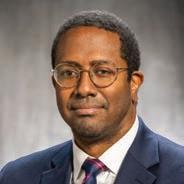
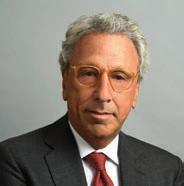











Rory Christian** Chair and CEO New York State Public Service Commission
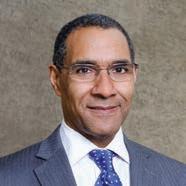
Barry M. Gosin Chief Executive Officer Newmark

Raymond J. McGuire President Lazard

Gemma Postlethwaite Chief Executive Officer GLG

Sean Decatur President American Museum of Natural History

Jon Henes Founder & CEO C Street Advisory Group




Alan D. Schwartz Executive Chairman Guggenheim Partners, LLC

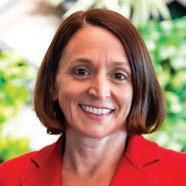
Anish Melwani Chairman & CEO LVMH Moët Hennessy Louis Vuitton Inc

Kevin P. Ryan Founder & CEO AlleyCorp

Steven R. Swartz President & CEO Hearst


Richard Dewey**
President & CEO New York Independent System Operator
Sally Librera**
President National Grid New York
Jed Walentas Principal Two Trees Management Co, LLC

CrainsNewYork.com/CrossroadsEvent






Anthony Pompliano Chief Executive Officer Professional Capital Management, LLC

Reihan Salam President Manhattan Institute for Policy Research
Henry Timms Chief Executive Officer Brunswick Group
** Sponsored Speaker



To
JB&B
Barnes & Thornburg

Li (Lily) Huang, PE, joins JB&B Environmental as their newest Senior Consultant, bringing over thirty years of experience in fields including environmental, civil, and public health. Lily is the former Assistant Commissioner for the Bureau of Environmental Sciences and Engineering at the NYC Department of Health and Mental Hygiene.
JB&B Environmental welcomes her extensive expertise and leadership to the continued development of their environmental consulting and technical services.
Tommaso DeNardo has joined J.P. Morgan Private Bank in New York as an Executive Director and Banker. Tommaso advises an array of New York–based clients, including C-suite executives, business owners, family offices, financial professionals, members of the entertainment community and foundations, leveraging his many years of brokerage and wealth management experience. Tommaso joins the firm from BNP Paribas.

J.P. Morgan Private Bank
Tim O’Mara has joined J.P. Morgan Private Bank in New York as a Managing Director and Banker in the Law Firms Group. He takes a hands-on approach to helping clients achieve their goals in areas such as investment portfolios, retirement, tax and estate planning needs, hedging strategies and more. Tim joins the firm from Wilmington Trust.

Barnes & Thornburg has added partner Dino Wu to the firm’s Corporate Department in the New York office. Wu is an experienced derivatives and financial services attorney representing sell-side and buy-side clients, including hedge funds, mutual funds, corporations, banks, and swap dealers, in negotiating trading agreements for derivatives and other financial products. He also assists clients in navigating the complex regulatory and compliance issues.

automotiveMastermind automotiveMastermind, the automotive industry’s trusted data and technology provider, has promoted Jeremy Carter from vice president of business operations to chief operating officer, effective Oct. 2024. As COO, he will ensure the organization aligns productmarket fit for continued growth and sustains a culture of innovation to maintain its competitive edge. This role is critical to the group’s high growth and will ensure operational excellence as it delivers consistent innovation and results.

Community Counseling & Mediation

Community Counseling & Mediation (CCM), a leading provider of behavioral health, supportive housing and youth enrichment services, has announced the appointment of Douglas C. Brooks as its new President and Chief Operating Officer. In his role, Mr. Brooks will be transitioning and leading the organization to best serve New York City’s most vulnerable.
Board Chairperson, Russel Shuler states “we are fortunate and pleased to have Mr. Brooks to continue and to build upon his father’s legacy.”
NONPROFIT
Community Counseling & Mediation


Community Counseling & Mediation (CCM), a leading provider of behavioral health, supportive housing, and youth services, has announced the appointment of Carmen Collado as its new Chief Operating Officer. She will oversee daily operations, lead the strategy for building collaborations and partnerships through the community and co-lead the execution of its long-term strategic initiatives. Mr.Brooks, CEO of CCM states “we are thrilled to have Carmen join our team and contribute to our growth.”

Stensul, the Marketing Creation Platform™, has appointed Tzi-Kei Wong as SVP of Product, and Angela Han as SVP of Customer Success. Wong brings over 15 years of product and design experience. She previously served as Chief Product Officer at Yext, and before that, she led product innovation at Optimizely. Her career also includes leading product at Welcome (formerly Newscred) until its acquisition by Optimizely. Han brings over 20 years of experience in customer success and lifecycle management. She previously served as Chief Customer Officer at Upside, Retain.ai, and Pluralsight. She was also VP, Customer Success and Professional Services at SendGrid, where she introduced new onboarding, services, and customer engagement programs.
The young professionals leaving their mark on New York’s business community are committed to making the city a better place. They are addressing key issues such as the migrant crisis, the need for diverse perspectives in the workplace and the dearth of affordable housing, and working in industries as varied as the news media, law, real estate, health care and advertising. They are also teaching the next generation to love the arts and books, and serving as an example of Olympic proportions.
Crain’s 2024 class of 40 Under 40 honorees includes some of the most ambitious, driven young people in New York. Read on to be inspired by the professionals rolling up their sleeves and doing what needs to be done.
—TELISHA BRYAN, MANAGING EDITOR
PHOTOGRAPHS BY BUCK ENNIS CrainsNewYork.com/awards/40-under-40-2024

Vice president of government affairs, SL Green Realty Co.
Garrett Armwood comes from a family of lawyers and had long assumed that would be his profession too. But a stint as a paralegal early in his career left him cold, so he decided to work on former Long Island Congressman Tim Bishop’s 2010 reelection campaign instead of continuing down the attorney track. He quickly found that politics provided him with a burst of enthusiasm he hadn’t felt before.
“It was just a very, very exciting campaign to be a part of,” he said. “That sparked a love of campaigning and an understanding of the way that politics and getting people elected then influence the outcomes we have in government.”
Armwood would stay in politics for more than a decade, most notably working in U.S. Senate Majority Leader Chuck Schumer’s office for about seven years. He served as the senator’s deputy state director and helped spearhead projects including refinancing the federally backed mortgage at Co-op City in the Bronx and establishing the Department of Energy’s electron ion collider, a $2 billion project, in Long Island’s Brookhaven National Laboratory.
But by the fall of 2023, he decided he was ready for a new challenge and took a job at SL Green, where he now works as vice president of government affairs. The real estate giant was widely seen as a winner in this year’s state budget process thanks mainly to the included tax-incentive program for office-to-residential conversions, which the firm and Armwood were strongly advocating for. He is now pushing for two ongoing projects that will be major tests of the firm’s influence: SL Green’s attempt to get one of New York’s highly coveted downstate casino licenses and the firm’s backing of the pro-housing initiative City of Yes from Mayor Eric Adams’ administration.
Although Armwood has seen some similarities between his jobs in politics and real estate, he is more enthusiastic about the differences, as they are where he feels he has the most room to learn.
“The thing that I was most excited for in coming to SL Green was learning that new skill to give me space to grow and develop myself and my career,” he said.
“
I’ve been blessed to work for some prominent people in New York: leader Schumer and now SL Green CEo Marc Holliday. The similarity I see is work ethic. Chuck still campaigns like he’s 20 and fighting to get in the Assembly. Marc still fights like he’s an associate in the investments group. That’s an ethos that I hope to embody for the rest of my life.”
Esther Castillejo distinctly remembers, at around age 10, when she became hooked on Tv news. “It was CNN covering the crisis in Darfur. I wasn’t proficient in English — there was only so much of the actual narration that I could understand — but I understood the pictures,” the native Spanish speaker said. From western venezuela, where she grew up, she “loved feeling so connected.”
The self-proclaimed “grateful nerd” studied journalism at Loyola University and attended graduate school at Columbia, parlaying internships (at CNN, Human Rights Watch and others) and a fellowship at ABC News into a job at “World News Tonight With David muir.” There she rose from anchor assistant to producer.
World News Tonight was the most-watched program across all U.S. television on monday, Sept. 16, with nearly 7.6 million viewers, according to Nielsen media Research. That was a 9% boost in viewership from the same monday the year before.
“On a normal day, I’ll work on a piece for the newscast with a correspondent and senior producer and editor,” she explained. “Once we lock in a script, I go to the edit room, and we put it together up there. Other times I work on enterprise stories, where I put together a team and budget. What is necessary to tell this story, to bring people on this journey? What are the most important visuals we need to get? Who are the people we need to meet? In so many cases, you just have to go in and find the people affected.”
That’s what happened with two of her biggest stories. Her team won Emmy awards for reports on the climate catastrophe in madagascar. And the Alliance of Women in media honored her for producing reports on the impact of the climate crisis on South Sudan. As a side effect, the Sudan stories led to nearly $5 million in donations to the U.N. World Food Programme.
“A lot of people think it’s more of a glamorous job than it is,” said Castillejo. “It’s a lot of minutiae, not just making sure details are right with lenses and lights and that it’s all within your budget. It’s also making sure that everyone is getting where they need to be, that David has what he needs, that fact-checking is done. It’s going through every frame of footage in the editing room to identify the most editorially significant moments.
“Then you get to literally push the baby to the server and watch it on Tv and see people reacting,” she continued. “It’s kind of great.” — LOU HARRY


Gabby Cazeau has had an unconventional career path: engineer at a food company to venture capitalist.
Though she’s thankful she no longer has to do equations, she says the two worlds aren’t all that different.
“As an engineer, you learn to look at the world and see problems in a different way, think about how to solve them, how to break them down creatively to the building-block elements of what they are,” she said. “In venture, you do a lot of the same.”
Cazeau began her career in research and development at General mills. Now, as a partner at Harlem Capital, an early-stage venture capital firm focused on investing in diverse startup founders, she meets with entrepreneurs with “incredible ideas and optimism” about solving “the big, messy problems of the future.”
She started at Harlem Capital as an intern in 2018, when the fund was being launched, while getting her mBA from Yale. After graduating, she returned to the firm as a fellow and quickly climbed the ranks, first to senior associate, then to principal and finally, in 2023, to partner.
“When someone offers you a seat on a rocketship, you get on and go to mars,” she said of her journey at the company, evoking technology titan Sheryl Sandberg. Harlem Capital has invested in 60 companies, focusing on diverse founders. The average funding amount is around $2 million. The first fund raised by the firm in 2019 was $40 million, and the second, in 2020, more than tripled that, reaching $134 million.
“ Authentic relationships pave the way to so much more. At the end of the day, you’re only as strong as your community and the relationships you’ve built. The more you invest in them and give, the more it comes back to you tenfold.”
When evaluating startups, Cazeau looks for a sense of vision, relentlessness and grit, a bit of a chip on the founder’s shoulder. She also looks to be inspired, an intangible yet critical trait that people who must secure enough buy-in from funders, customers and employees to join them on a journey to an uncharted future must elicit.
“I went to business school to find bigger opportunities and take a big leap,” she said. “I found that at Harlem Capital.”
— AmANDA GLODOWSKI
Matt Charles describes the scenery surrounding his grandparents’ bar in Wales as something “straight out of Lord of the rings,” complete with wild horses roaming a nearby mountain and a river he’d jump into “butt-naked” as a child. Inside the Usk and railway Inn, a glamorous though hunchbacked lady would play piano while his grandmother’s friends taught him to wink. each week was packed for Sunday roast, and when a patron asked his grandfather for ice, he would reply, “This isn’t the North Pole.”
Now Charles, a partner at Authentic Hospitality, entertains clientele including Jimmy Fallon and the cast of SNL at rockefeller Center watering hole the Pebble bar, where one of the bartenders was recently requested for Al roker’s birthday party.
Though the setting is dramatically different from that of his youth, Charles maintains that community is central to success in the hospitality business and a main priority at properties Authentic manages, such as ray’s, Jac’s on bond and bar Calico.
“People go [to bars] to celebrate, to mourn and for connection,” Charles said. “They go there to feel safe and to be treated kindly.”
He was particularly inspired by a podcast he heard during the pandemic on which legendary hotelier Ian Schrager, who founded Studio 54, said that it’s rare in life to get an opportunity to change the course you’re on, and Covid presented one of those moments.

Charles sold his equity in Golden Age Hospitality, where at the time he was chief operating officer and managing partner, and met his now co-partners, Carlos Quirarte and matthew Kliegman, known as the “nice guys of hospitality.” Charles was drawn to their values and noticed that they treated their employees with kindness and respect that echoed his grandparents’ business. After “dating slowly,” he went all in.
The approach has paid dividends: Authentic’s revenue has grown year over year for the past three years, from $16 million in 2022 to $25 million in 2023 and $50 million in 2024.
Though Charles and his team are on a hot streak, recently acquiring the broken Shaker, which will allow them to operate nationwide, he maintains that no task is beneath him.
“I don’t have a problem getting on my hands and knees in a suit and putting my hand into the drain,” he said.

Lauren Crowley Corrinet Vice Chairman New York City
CEO and founder, Percent
After two and a half years of working in finance, Nelson Chu knew it wasn’t for him. So he left and founded a strategy consulting firm. That company ultimately partnered with clients who went on to deliver more than $1 billion in shareholder value. Chu resisted working with finance technology companies, but his finance background kept drawing him in.
“Like it or not,” he quipped, “I was stuck in fintech.” He soon realized it was time for a new adventure.
In 2018 he founded Percent, which connects small, medium and large institutional investors with corporate borrowers and allows them to compare private credit investment opportunities. The company has more than 35,000 users and from its inception through the end of 2024 is projected to generate nearly $20 million in revenue, with core revenues doubling every year for the past three years. Through its marketplace, over 700 deals have been funded, amounting to roughly $1.3 billion.
From a young age, Chu disliked school and focused instead on what interested him most. His father supported this exploration as long as his grades didn’t drop. Chu got a mac in 1999, “before anybody had [one],” and taught himself Photoshop and movie making. He spent weekends teaching himself how to modify his car. “Zero academics,” he noted with a laugh.
This passion for self-education has made him a more agile entrepreneur. A startup is “organized chaos,” he said, and “no two problems are ever the same.” but learning through all of it is part of the fun: “It keeps you on your toes

and forces you to question yourself, your own decision-making, your strategy.”
The best thing someone aspiring to launch a company can do is to take the plunge, Chu said. “Never bet against yourself. Always have the confidence that you will be able to figure it out.” Nothing’s ever as bad as it seems, he added. “but nothing’s ever as good as it seems either. So stay as level-headed as you can throughout the process.”
CBRE proudly congratulates Lauren Crowley Corrinet on being recognized as one of Crain’s 40 Under 40. This honor highlights her leadership, vision, and accomplishments. We also extend our congratulations to all the honorees recognized this year.
www.cbre.com

On the most basic level, Lauren Crowley Corrinet is a real estate broker. But her job at CBRE, analyzing potential high-level commercial transactions for blue-chip tenants such as Sotheby’s auction house and the Archdiocese of New York, is really more akin to that of a problem-solver, she says.
“We’re the ones who make the strong business case,” Corrinet explained.
Corrinet is an Upper West Side native who grew up near Philadelphia and attended college at Barnard. Upon graduation, she snagged her job at CBRE, the world’s largest commercial real estate services and investment rm, which took in $31.9 billion in revenue in 2023, and never left. Working anywhere but New York was out of the question. “I have this absolute love affair with the city,” fueled by real estate, “which you can touch, feel, see and help build,” she said. Some deals have been clever enough to earn her nods from the Real Estate Board of New York. In 2015 she and her team convinced social-media giant LinkedIn not to leave the Empire State Building for a property with an industrial-chic look but to instead add a 100,000-squarefoot berth in the skyscraper featuring stone oors and exposed columns.
Years later, with the economy softening and LinkedIn seeking to downsize, Corrinet devised a different strategy. In a tricky three-way negotiation, LinkedIn was able to break its lease. The landlord, Empire State Realty Trust, of oaded the space to production company Backlot, and LinkedIn promised to rent additional square footage down the road.
“It was better than allowing a huge glut of sublet space to sit,” said Corrinet of the deal, which also scored a REBNY award.
Today she; her husband, Christopher Corrinet, who’s also a CBRE vice chairman; and their two children live in Greenwich, Connecticut. But the city’s always on their minds: Expect interruptions if you join them for a movie set in New York, Corrinet jokes.
“We’ll see a colored light on the roof and say which building it is, who owns it, who controls the debt, almost like we’ve created this encyclopedia,” she said. “These places are near and dear to our hearts.”
— C. J. HUGHES





Partner and co-head of insurance M&A and reinsurance, Skadden, Arps, Slate, Meagher & Flom LLP
Elena Coyle gets a thrill from pulling off a complicated business deal. An attorney advising insurance companies, asset managers and private equity clients on mergers, acquisitions and other transactions, she has spent more than a decade helping clients complete what can feel like an impossible puzzle.
“I’d say that’s probably what got me hooked at an early age,” she said.
Coyle, a native of boston, learned the finer points of negotiations by watching her father, who was Ceo at the AFL-CIo Housing Investment Trust, figure out how to use stable pension investments to develop affordable housing projects worth billions. She spent her summers during high school and college interning at the trust, which allowed her to sit in at the negotiating table with general counsels and executives, watching deals get done.
“It emphasized for me that the advice given to an executive always needs to be actionable, practical and commercial,” Coyle said. “It was really influential.”
Coyle also followed in her mother’s footsteps by
becoming an attorney. She graduated from Stanford Law in 2010 on the heels of the financial crisis, when the insurance industry was one of the few still embarking upon large-scale acquisitions and consolidations.
She started at Skadden as an associate straight out of law school, and has worked with clients such as Liberty mutual and Centene Corp. After being elevated to partner in 2019, she now leads insurance m&A and reinsurance practices at the law firm and has worked on deals worth more than $200 billion over the course of her time there.
Coyle strives not only to be remembered for the legacy of the deals she has done, but also by the mark she’s made on the insurance law industry. And the mother of three, who has a baby on the way, is dedicated to making her profession more inclusive for women.
“I derive a lot of strength from the time I spend with my family,” Coyle said. “I encourage my team to find the thing that inspires them or restores them, and make time for it.”
— AmANDA D’AmbroSIo

For Dr. brenton Fargnoli, medicine and business have never been mutually exclusive.
The board-certified physician leads the health care team at Flatiron District-based venture capital firm AlleyCorp, which he helped launch when he joined five years ago. Health care is now the single-largest focus area of the firm, whose investments include Pearl Health and Thyme Care.
Fargnoli has backed more than 30 companies, with AlleyCorp serving as an incubator or first investor. The firm, founded by tech entrepreneur Kevin ryan, has invested over $150 million in health care startups that have raised more than $1 billion in capital, according to the company.
“brenton has redefined what it means to be a physician-entrepreneur. He is truly one of the most innovative minds in digital health,” ryan said. “especially in New York, but also all over the country, brenton has done tremendous work to reshape the landscape of health care, leading to better patient outcomes and more
access to care.”
The more you do, the more you can do.”

Money can be a sensitive subject, even for wealthy people. As head of the merrill Center for Family Wealth, valerie Galinskay a helps clients and their families figure out how to broach the topic — and how to make progress once they have.
“I’ve always been really fascinated by the intersection of finance and psychology,” she said. by helping some of the world’s most financially successful people navigate these loaded conversations, she hopes to empower them to define the purpose of their wealth and be intentional about its impact on their families and communities. Galinskay a, who as a child immigrated to the States with her family from Ukraine, has helped hundreds of clients make decisions about how best to use their money while preserving family harmony, counseling them on everything from discussing their resources with their children to implementing philanthropic strategies. In doing so, she has directly contributed to more than $2.5 billion in new assets for the firm.
The most rewarding part of her job is helping people
be “candid and vulnerable” about their values and priorities. “A lot of the conversations, discussions and, sometimes, disagreements I see about money are not about money,” said Galinskaya, who has been with the merrill Center for Family Wealth since 2014 and also had a stint at merrill earlier in her career. “making that personal connection with somebody and helping them define what success means to them is really, really meaningful.”
She also finds satisfaction in helping younger people expand their financial knowledge. “The rising generation especially is very intimidated about [finances] — investing, planning, trust, what all of this means,” she said. “And I am a big proponent of demystifying that.”
She says it’s important to keep an open mind when guiding clients through these types of discussions. “I always say to families, ‘I come with zero judgment,’” Galinskaya said. “I’ve [come to realize] that every family is unique; every family has its nuances.” Ultimately, she added, “my goal is to be a facilitator and hopefully to provide them with candid feedback and really help them achieve what’s important to them.”
— rAINA LIPSITZ
“The biggest thing I’ve learned is not to put yourself in certain boxes and not to allow others to put you in particular boxes.”
Fargnoli has seen the company grow several times over the years, moving from humble quarters in conference rooms to a 6-story building on broome Street that it purchased for $41 million in 2022.
earlier this year, the firm announced that it had raised $250 million from external investors, almost half of which is earmarked for the health care portfolio, Fargnoli said.
After a traditional pre-med course, Fargnoli “caught that business bug,” studying the economics of health care at the Wharton School while in medical school at the University of Pennsylvania. He began developing his own startups in the city as an executive at Flatiron Health before joining AlleyCorp in 2019.
“The fact is, we start these companies [from] an idea on a napkin,” he said.
And at the time, he never took off his white coat. He spent his Thursday nights treating patients at memorial Sloan Kettering.
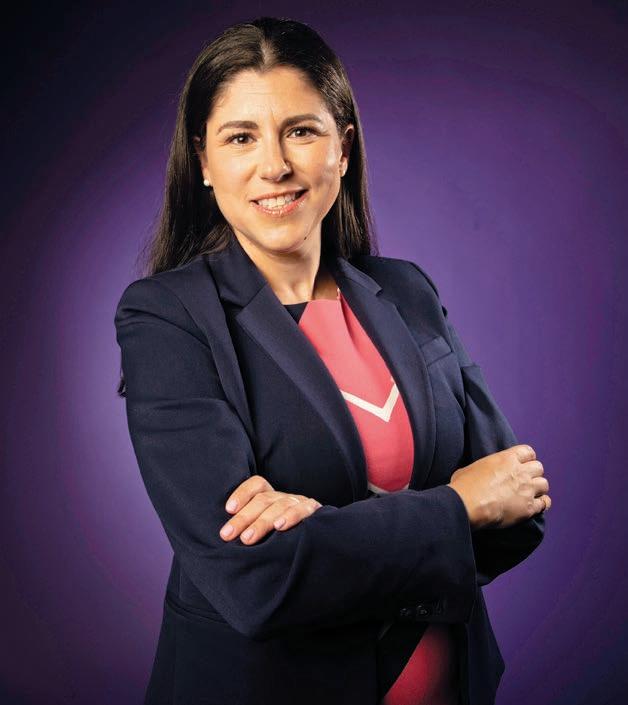
Fresh out of college in early 2009, Krystyn Gatto was figuring out a career focus when a family friend suggested commercial real estate. She took a job offer from retail leasing brokerage Colliers International, a decision that changed her life.
“I found a passion in shaping the world around me,” said Gatto, who, after working at Colliers and SL Green, is now the chief operating officer for Avdoo & Partners, a boutique real estate development firm based in midtown that has residential, retail and mixed-use projects in its portfolio.
At Avdoo, Gatto has a hand in all aspects of the development process. That encompasses acquisitions, predevelopment, equity and debt fundraising. Since joining the firm seven years ago, she has been involved in over 1 million square feet of development, valued at nearly $1 billion. Key residential projects include 323 Bergen St. and 58 St. marks Place, both in Boerum Hill, Brooklyn.
“We brought Saint marks to market in January of 2021, which was a precarious time,” said Gatto, who also oversees sales, asset management and investor relations for the

company. “Despite launching during the pandemic, we had fantastic sales.” Additionally, Bergen Street has outperformed any other new development in the Brooklyn market, she says.
Because Avdoo serves as the general contractor on its projects, Gatto stays informed on costs and construction, and maintains a connection between the development and building teams. “That is our special sauce,” she said.
Under Gatto’s leadership, Avdoo has grown from six people to over 50, with plans to move to a larger office space soon. Yet she prioritizes each individual at the firm. “I was the first to have children while working here,” she said. “Setting policies and standards has been important to me, because I want to make sure we can foster talent and retain it long term through the various points of our employees’ lives.”
A mother of two young children, Gatto rides her bike to and from work, a 25-minute trip that has become instrumental. “It allows me to get exercise and transition between the different parts of my day,” she said. —
“ Take risks and be all right with it not working out, because those moments when things don’t go according to plan are opportunities to grow individually and show where you can add value to the company. In challenging times, there is tremendous growth potential.”
since 1993

After 12 years, Compass, one of the nation’s largest real estate brokerage firms, finally reached the promised land of profitability during the summer. rory Golod is a big reason the company got there.
The task for Golod, who has been with Compass practically since the beginning, is to make sure the firm’s force of 35,000 real estate agents has everything they need to sell houses or lease buildings.
“my job is to know exactly what the pulse is, where things are and what matters,” he said.
Golod has never been an agent, although his brother is one. but real estate seemed interesting after a short stint in software and data analytics post-college. And working for a startup sounded inviting. He joined Compass in 2014. Compass raised billions in venture funding and went public in 2021. Then everything got much harder. rising interest rates cooled the housing market, and unprofitable Compass looked as if it might join the ranks of well-funded startups that never evolved into prime-time players.
It was quite the education for the Cold Spring Harbor, Long Island, native, who caught the entrepreneurial bug in fourth grade. His school was holding a fundraiser, and he felt compelled to sell the most cookies. The prize for winning: a lava lamp. He kept it for years.
“I just remember being obsessed,” he recalled. “I canvassed the entire town.”
After years of restructuring and retooling, Compass generated $20 million in net income






“Don’t ever doubt yourself, even when others do.”
in the second quarter. And with interest rates starting to come down, the housing market is starting to come back up. Compass appears to be in a solid position.
“We worked hard and never gave up,” said Golod, who is the firm’s president of growth and communications. “And now we’ve got a company that will be around for decades.”
— AAroN eLSTeIN
Jack Hamilton has been arguing their case ever since they were young. The child of a police officer and an investigator for a district attorney, Hamilton says there was never a time when they thought they would grow up to be anything other than a lawyer. Today, as one of a select few transgender, nonbinary litigators in New York, Hamilton has risen to the ranks of partner at Wilson Sonsini Goodrich & rosati, where they represent public and private companies in a variety of mergers-and-acquisitions transactions.
In 2022 Hamilton was working on Sony’s $3.7 billion acquisition of bungie, the video game studio most famous for creating “Halo” and “Destiny.” Hamilton said they felt a deep, personal connection to the deal because they grew up playing “Halo.” It was also during the closing of the merger when Hamilton found out they were promoted to partner.
most recently, Hamilton was at the forefront of the video-messaging unicorn startup Loom’s $975 million acquisition by software giant Atlassian.
“one of the things I love most about my job is working with the [startup] founders on the sell side,” they said. “There’s often a great financial payoff, but there’s a lot of emotions that go into that. The fun for me in m&A is getting people to see the joy of the exit transaction for this company you’ve spent so long pouring

your heart and soul into.”
It’s that focus on developing a connection with clients that Hamilton credits as allowing them to quickly climb the corporate ladder at a young age. They say it’s a skill they’ve been honing ever since they came out as gay as a teenager growing up in a religiously conservative setting. Hamilton says their experience engaging with people with varying opinions and beliefs helps them build trust with clients in high-stakes business situations.
“being visible is scary for me,” they said, “but it’s an important point that I bring to my work.”






























SL GREEN, VICE PRESIDENT FOR GOVERNMENT AFFAIRS






















With a degree in anthropology, Tara Hariharan uses her social sciences background to inform her career in financial services. As head of global macro research at NWI management, a midtown hedge fund focused on fixed income, currencies and interest rates, she offers a unique perspective on world markets and policy.
Hariharan joined NWI after graduating from Princeton in 2007. “I cut my teeth on the great financial crisis and then the European debt debacle a few years later,” she said.
A fast reader and distiller of information, Hariharan anchors the investment process at NWI, running a daily briefing meeting on economic and geopolitical news for the firm’s 20-person team in addition to her other responsibilities.
On an average day, NWI executes over $6 billion in trades across different asset classes, which are driven by Hariharan’s observations and recommendations. “Some people work 9 a.m. to 5 p.m.,” said Hariharan. “I basically work from 5 a.m. to 9 p.m., in the sense that I am covering world markets from New York during those hours.”
Hariharan has made some important calls recently. “In the spring of 2023, I picked up on the possibility that the Bank of Japan would begin raising interest rates this year and recommended shorting Japanese government bonds,” she recalled. “While Japanese monetary policy had been easy for decades, this proved to be very prescient.”
She is also one of only a few analysts who went on record as early as late 2022 to forecast that China’s economic recovery post-Covid would be muted.

“ I am constantly being intellectually challenged by the blazing-fast pace of development in markets and international affairs.”
Though she didn’t have formal economics training, Hariharan was intrigued as an undergraduate by the opportunity to apply her social sciences expertise to finance. “Even markets are driven by behavior and interactions between people,” she said. “At NWI, we don’t purely rely on numerical data; we do a lot of top-down work that involves talking to policymakers, gauging their reactions and trying to understand what they will do rather than what the markets tell us they will do.”
— DIANE HESS
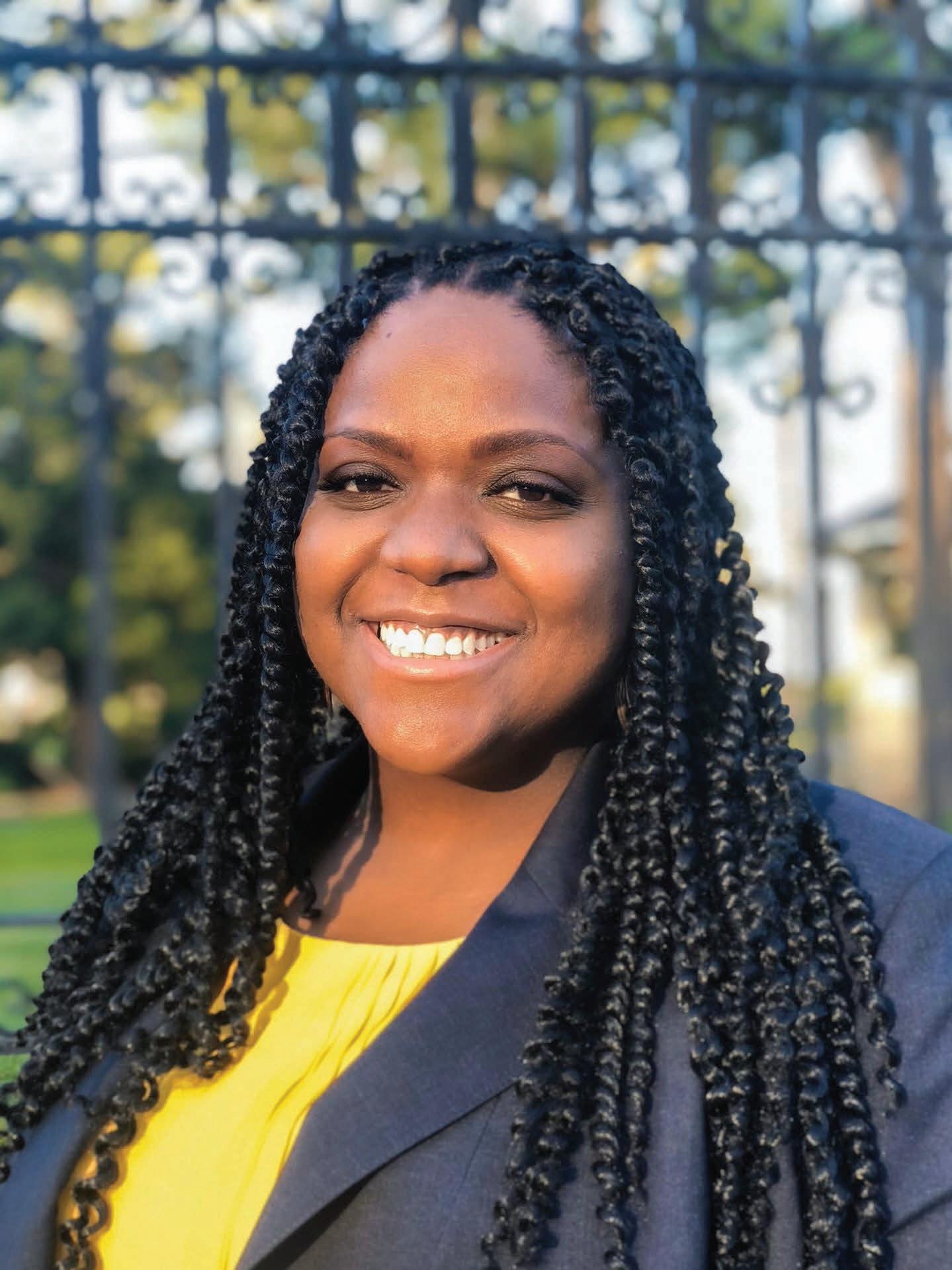
When Priyanka Jain was experiencing health issues during the pandemic, she visited what felt like an endless list of doctors. but she often left their offices with few answers and tired advice: Drink water, get more sleep and reduce stress.
“If you’re a woman, at some point you just end up having a frustrating health care situation,” Jain said.
After doing some research, Jain discovered the reason for her frustration: Clinicians have limited data about the female body. Women weren’t included in U.S. clinical trials until 1993 – meaning that most mainstream medical guidance is based on studies that only included middle-aged white men, she said.
At the time Jain was working as head of product at Hr-tech startup Pymetrics, using data to predict candidates’ chances of getting a job and to create more equitable hiring practices. She figured if she could use data to predict hiring, she could also use it to boost women’s health care.
Jain co-founded evvy in 2021 to sell at-home vaginal

microbiome tests aimed at helping women better understand their health. The Flatiron-based startup launched right as at-home testing and telehealth became mainstream during the pandemic, earning it a $5 million seed round led by investor General Catalyst. evvy, which has 19 full-time employees, has raised $19 million to date.
The tests, which cost $129, or $99 with a subscription, can detect more than 700 types of bacteria and fungi in the vagina. After testing, patients can get a personalized report on their microbes — and how their genetics might contribute to bacterial infections, infertility and gynecologic cancers.
Patients can also choose to contribute their deidentified data to a repository of information on female-specific biomarkers to improve clinicians’ knowledge about women’s health, which 98% of patients have agreed to do, Jain said.
“I would love for my contribution to be in data and research,” she said. “And it feels like I can actually do that.”

Senior assistant vice president of care models, Office of Ambulatory Care and Population Health, NYC Health + Hospitals
At the height of the pandemic, one of the city’s most tangible interventions went almost entirely unseen by most New Yorkers. And Dr. Amanda Johnson was the one in charge of those municipally funded isolation hotels that operated behind the scenes.
Her career has placed her at the forefront of New York’s most critical public health crises, from a novel pandemic to the cracks where services end for people leaving lockup and the shelter system.
In April 2020, only weeks into her new job as interim chief medical officer at the Sydenham Health Center, one of New York City Health + Hospitals’ Gotham Health clinics, Johnson was tapped to lead the Test & Trace isolation program and take on the mountainous task of helping a city shelter in place.
Under her leadership, the program provided 33,000 hotel stays for New Yorkers, and delivered $2.1 million in cash assistance and 2.2 million meals, according to H+H. Johnson is still heading up the city’s AfterCare program for long Covid, funded in part through a grant from the New York Health Foundation.
The doctor, a milwaukee native with a background in internal medicine, has stepped in to lead the system’s work financing health care for people experiencing homelessness and those reentering society at large. Through the Street Health outreach & Wellness program, Johnson’s teams have engaged with more than 240,000 New Yorkers, providing 30,000 medical consultations, 9,000 vaccinations and 67,000 interactions with social workers since 2021, according to H+H stats.
“It’s not an if-you-build-it-they-will-come model,” Johnson said of the need for outreach.
This year her staff launched an emergency department navigation program at Woodhull m edical Center and a homelessness consultation service at b ellevue Hospital.
meanwhile, Johnson has not stopped treating patients despite her rise in the administrative ranks of the country’s largest public hospital system. She continues to provide primary care and substance-use treatment at Sydenham in Harlem.

One of the city’s top real estate lawyers, Ali Krimmer has always found her specialty compelling. “It’s a tangible asset,” she explained.
Krimmer is a partner at Arnold & Porter, where she has worked on sales, purchases, and lender- and borrower-side financings and restructurings worth billions. She has represented some of the firm’s largest real estate clients, including blackstone, magna Hospitality, Grandview Partners, Crédit Agricole and Affinius Capital. Her genuine passion for the work has fueled her success. Krimmer sees real estate as a largely “nonadversarial” field and finds satisfaction in bringing people together. “being a lawyer in any aspect requires a bit of theater,” she noted. “of course, you’re negotiating and advocating for your client as hard as you possibly can. but it’s nice when you’re at a closing and everyone ends up happy.”
In addition to managing complex, multimillion-dollar negotiations, Krimmer supports and mentors junior and
women associates. “Sometimes you have to be a little bit of a therapist,” she said. “The reason [I’ve spent my entire career at Arnold & Porter] is because I’ve always felt supported and encouraged and that I was treated with respect even when I was a junior associate. And that’s what I try to do for everyone else, to kind of pay it forward.”
Krimmer made partner in 2023. What would she tell a colleague aspiring to do the same?
“everybody knows that you need to work hard,” she said. “but I think it’s [more that] you need to push one step ahead of what that means … separate yourself in whatever way that is, whether it’s by taking ownership of pieces of a deal that you weren’t necessarily assigned, taking action, seeking out more. make it known that you want to go the extra mile.”
At the same time, she added, people should know that it’s oK to be themselves: “You can have a personality and still do your job.”
“It’s super important to know your business and know the law, but it’s equally important to be a good person. Having a sense of empathy and compassion is just as important.”


Executive chef, Coqodaq
For Seung Kyu Kim, it’s not enough for the fried chicken at his wildly popular eatery Coqodaq to just taste good. It also has to be good for you, which became clear after a recipe-testing odyssey during which he ate towering helpings of poultry sizzled in oils made from olives, avocados and seeds.
“After, I felt like my body was not functioning well,” said Kim, who instead opted for an oil extracted from sugarcane that retains “good fats” after heating. “It’s, like, ve times more expensive,” he said, “but the health bene ts are great.”
Cooking wasn’t always in the cards for Kim. Growing up in South Korea, he once considered working for his grandparents’ car-manufacturing business before discovering reality shows starring chefs like Gordon Ramsay, which steered him to the Culinary Institute of America. He later honed his chops in the kitchen at ne-dining icon Jean-Georges and along the way struck up a friendship with restaurateur and fellow Korean American Simon Kim. Both agreed New York was lacking in places to enjoy fancy fare in an unpretentious setting.
To ll that void, in 2017 Simon Kim’s Gracious Hospitality Management opened Cote Korean Steakhouse, a barbecue-focused offering in the Flatiron District that quickly earned a Michelin star before becoming a global brand. Seung Kyu Kim joined his friend in 2019, and a few years later they bet that a crispy cuisine rivaling kimchi as Korea’s national dish could nd a following here. Enter Coqodaq earlier this year.
A lofty 190-seat, 130-employee hotspot whose dim lighting and pulsing tunes emit a nightclub vibe, Coqodaq often sees velvet-rope-style lines form before it opens at 5 p.m. Once in, diners devour wings, thighs and nuggets, and wash them all down with hundreds of varieties of Champagne. The multipiece “bucket list,” with pickled veggies and soft serve yogurt, is $38, but a “black gold” single nugget with truf es is the same price.
Demand has been pleasantly surprising. At this year’s U.S. Open, Kim anticipated his Coqodaq popup selling 25,000 nuggets at about $4 to $17 a pop but ended up needing four times that. “We’re getting a lot of love,” said Kim, though true success would be to stay trendy for many decades, as SoHo’s Balthazar was able to do. “Longevity is very important.”
— C. J.
HUGHES
“ Life can be unfair, but if you constantly give 100%, 200%, and you’re patient, you can be rewarded.”
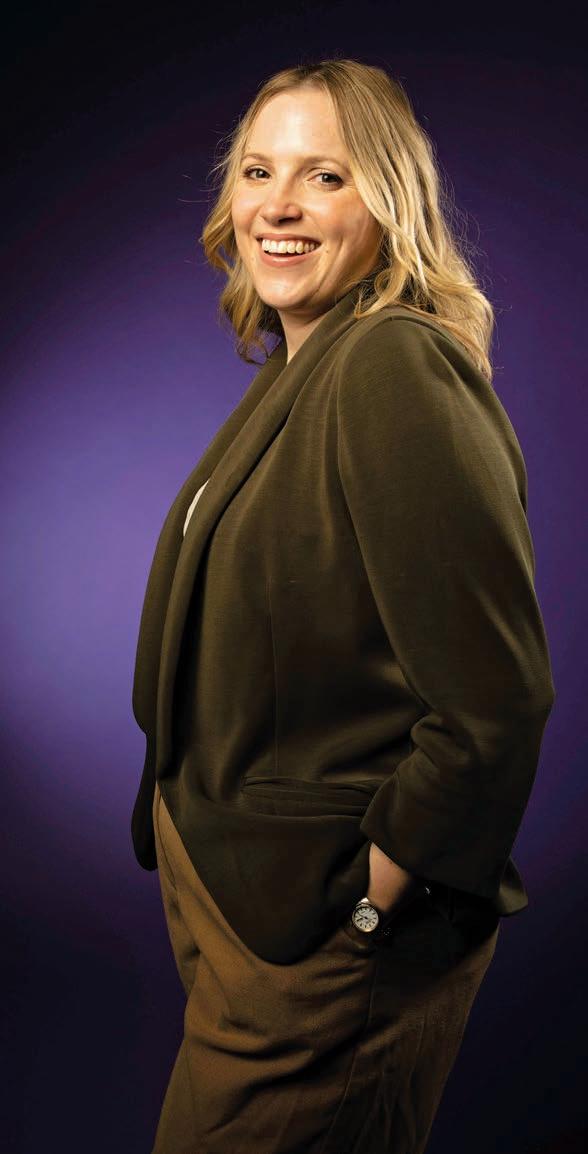
“ Communication and building relationships, including doing things that you don’t have to do for the people you work with, are the basis for success.”

Deputy
chief of staff to the mayor, New York City Hall
Madeline Labadie likens her job at City Hall to being a shepherd or an orchestra conductor. She pushes projects through years of planning and coordinates with the city’s vast and often insular agencies.
“It’s knowing all the people to call and making them all play together well,” said Labadie, deputy chief of staff to Mayor Eric Adams.
She oversees citywide events including the marathon and the U.S. Open, has spearheaded a Halloween initiative that has transformed dozens of city streets into car-free trick-or-treating zones, and is leading the city’s portion of planning for the 2026 FIFA World Cup matches taking place in New Jersey — projected to generate $2 billion for the region. She also co-chairs a 15-agency task force on micromobility and produces the policy-heavy State of the City speech.
All that requires the ability to understand each agency and “its own little culture and leadership structure,” Labadie said. She honed that skill at the Taxi & Limousine Commission, where she spent six years and led efforts on Vision Zero, the citywide push to reduce traf c deaths that she continues to work on today.
Labadie grew up in Oak Park, Illinois, a Chicago suburb whose history of promoting racial integration made her think about the power of government to improve lives. Catching “Obama fever” while attending New York University inspired her to pursue public service herself.
“Did I know exactly what that meant in terms of how many emails I’d read a day and how many phone calls I’d make and what coordinating a task force means? No,” she said. “But an important principle for me has always been to raise your hand and volunteer for something.”
Even in the best of times, the work can be slow and dif cult, and Adams’ indictment has dealt a blow to the administration’s power to implement its agenda. But the successes — such as the recent passage of city and state laws to curb the usage of re-prone e-bike batteries — make it feel worth it.
“When I’m not pulling my hair out because it’s hard,” she said, “it’s been a real pleasure.”
— NICK GARBER
Nearly every aspect of the life of Chris Lauber, senior director of operations at LT Hospitality management, revolves around food. even his French bulldog is named remy after the rat in the 2007 Pixar chef film “ratatouille.”
Lauber had dreamed of working in a kitchen ever since he was a kid growing up in michigan, admiring the careers of famous Tv chefs such as Gordon ramsay.
“I wanted to be a chef because I was seeing how much fun everyone was having in the kitchen,” he said.
When he was a teenager, Lauber began baking and at 16 was able to buy his first car from the money he made making wedding cakes. He then had the opportunity to learn under a local chef, who taught him about ingredients and techniques. The training eventually landed him a spot at the Culinary Institute of America.
After graduating from the CIA, Lauber was mentored by chefs Charlie Palmer, Jean-Georges vongerichten and George mendes, who helped guide him toward the front of the house to better understand the business aspect of the restaurant industry.
“I’ve never looked back since,” he said.
Lauber went on to lead the food and beverage program at the modernhaus Hotel in SoHo, which is part of Thor equities. In 2021 he assumed his post at manhattan-based LT Hospitality management, where he oversees a $24 million annual budget with a staff of about 300 employees across five locations, including Second, L’Amico and Hidden bar.
And all his hard work has certainly paid off. Lauber and his colleagues have shattered a previous $7.5 million annual record at Second by so far in 2024 exceeding more than $8.6 million in sales.
Lauber starts each day with a plan but says he remains nimble, as things can shift in an instant. but his favorite part is always the same.
“I enjoy the people. I enjoy getting to meet new guests every day,” said Lauber, who dreams of opening his own restaurant and hotel consulting firm within the next few years. “I enjoy getting to explore and create. It’s a combination of factors that really drive me forward in this industry.”
— JULIANNe CUbA
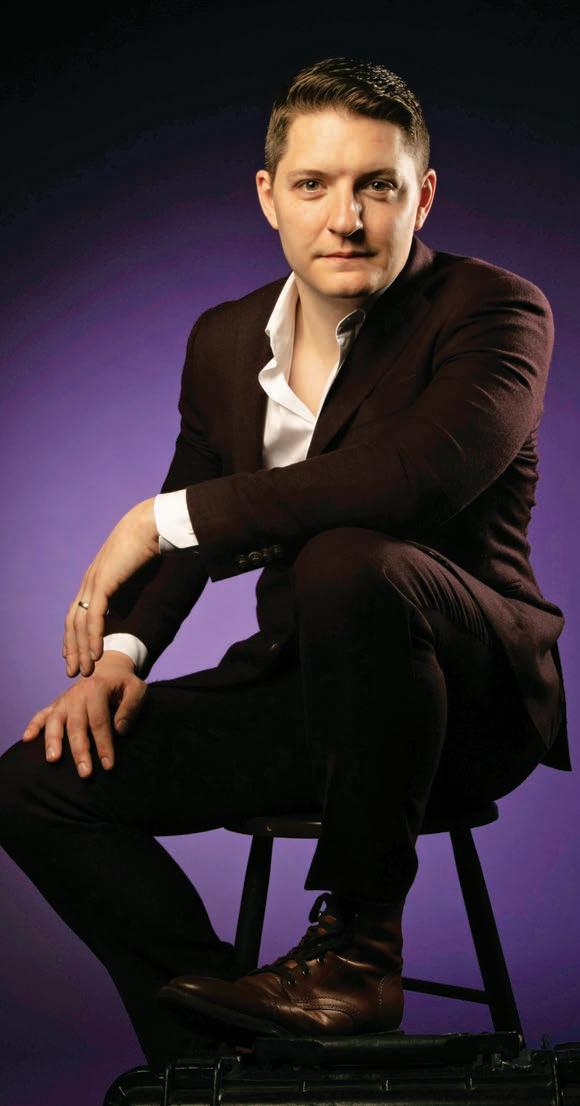

Compared with its grittier post-industrial self, the meatpacking District is now cleaner, calmer and more upscale. Jeffrey LeFrancois, the former chair of the neighborhood’s community board, Cb4, and the current head of its business improvement district, feels its transfor-
mation should not be reduced by a certain “G” word.
“Gentrification is often used more as a weapon than a definition of change,” LeFrancois said. “And change is the nature of the city.”
Signs of transition are ubiquitous. Under LeFrancois’ leadership, the district’s streets have given way to tens of thousands of square feet of landscaped sitting areas. Its plazas have added bold public art projects, such as the 100 elephant sculptures displayed now. but, of course, the pandemic’s effects linger, in that some vacant storefronts have yet to be refilled.
“but exciting things are coming,” LeFrancois said, including the return of longtime brunch mainstay bagatelle to West 14th Street; the opening of Chez margaux, a private club from chef Jean-Georges vongerichten, on West 13th; and the arrival of Tao Group’s Crane Club in 10th Avenue’s former Del Posto berth.
A Pace graduate who majored in political science, LeFrancois spent much of the early 2000s knocking on doors for political campaigns that mostly ended in defeat. “I understand the value of winning because I lost for so long in the politics game,” he said.
but persistence likely comes in handy when advocating for the interests of landlords such as Aurora Capital Associates, Taconic Partners and Google parent Alphabet, including about the reinvention of public property. His recent successes include turning an unused shoulder of 10th into a planter-lined, 7,000-square-foot retreat and adding a West Side Highway crosswalk to the year-old Gansevoort Peninsula park.
As with gentrification, development can have upsides as well, said LeFrancois, who helped shape Cb4’s unique pro-growth plan in a generally NImbY New York. The 2022 effort called for creating a hefty 23,000 housing units, 1,400 of them affordable, along the West Side through rezonings, increased density and other approaches.
“I believe in using every tool in the tool box,” LeFrancois said, “and the plan was certainly a significant tool to draw attention to a tremendous opportunity.”
— C. J. HUGHeS
Everything takes more time than you want it to, but that shouldn’t be a hindrance to setting an extraordinarily high bar. And surround yourself with people who are both supportive and critical.” “































































































Partner, Jenner & Block
As an adviser to companies facing complicated legal challenges, Jenner & Block partner Andrew Lichtman satisfies his long-term goal to be “challenged and never bored.”
At the global law firm, whose New York office is on Sixth Avenue, he handles complex civil litigation for clients including those on the cutting edge, such as companies in the AI, cryptocurrency and cannabis industries. Lichtman was on the legal team that in June favorably negotiated an innovative multistate settlement on behalf of Clearview AI. The class-action lawsuit centered on claims that the facial-recognition company’s controversial practice of “scraping” public photos from social media to collect in a database sold to private and public customers violated privacy laws. The yearslong litigation was an existential challenge for the New York-based tech startup with 45 employees.
“We put forward creative legal arguments and reached an agreement doable from the company’s perspective,” said Lichtman about the unique preliminary settlement that gives plaintiffs a share of the company’s value, rather than an immediate cash payout. One of the points that made settlement possible, he added, included persuading Clearview AI to drop its business customers and license its database only to governmental entities in order to conform to a data-protection law.
Lichtman also represented leading retail cannabis company Curaleaf in an arbitration with shareholders over allegations of breach of contract and fraudulent inducement to a settlement agreement. Arbitration often ends with a “split the baby” outcome, but after the two-week hearing in September 2022, the tribunal awarded a complete victory to Curaleaf.
“I do really enjoy the challenge of applying existing legal frameworks like securities laws to new industries and the interesting questions about laws clearly not written for these facts,” Lichtman said.
Then, too, his legal specialty keeps him on his toes. Complex civil litigation is “never straightforward, never easy and often presents something new,” he added.
“It’s an ongoing game of chess for three to five years. You always have to be playing the long game.”
— JEANHEE KIM

“ Take
ownership
and
be
proactive. [Don’t] drift along getting
assignments in a passive way, but develop relationships, take steps to develop relationships with people in your firm, and get clients and nurture those relationships.”
“ I
started out in investment banking and am working in art now. On either end of that spectrum, the client’s experience is what matters, being there for them during each phase of their journey.”

37
Chief commercial officer, Sotheby’s
Min Manhattan. When her colleagues come in, they enjoy helping to put the pieces together.
“Often my team makes comparisons between the puzzle and how they view me within the organization,” said Lissner, who as the chief commercial officer oversees global revenue for the company’s fine art, jewelry and collectibles businesses. “They know I am someone who can solve a problem and build something bigger than its parts.”
Having begun her career in investment banking, Lissner went on to lead the launch of an art investment fund at the advisory startup Art Agency Partners. In 2016 Sotheby’s acquired the firm, and she joined the legendary auction house. Lissner quickly rose to become head of the company’s $1 billion lending business, Sotheby’s Financial Services, and was promoted in 2022 to her current position, making her the youngest person and the first woman to serve in the role.
Lissner manages over 30 people and is responsible for dealmaking across Sotheby’s various business lines. She has been involved in high-value sales of paintings, diamonds and other rare items, including an upcoming $200 million collection from beauty industry mogul Sydell Miller.
Also under Lissner’s purview is a $30 million Mark Rothko painting that will be sold at a Hong Kong auction in November. “It will be the first time Rothko sells in Asia and one of the highest-value contemporary works of art on the market there,” she said.
In her youth, Lissner’s passion for art developed during visits to the Art Institute of Chicago, near where she grew up. Today she combines her financial expertise and creative acumen, striving to provide clients with fair and respectful experiences during negotiations.
Lissner interacts with art specialists, dealers, collectors, attorneys and bankers. “She is gifted in the world of art and the world of deals, with an ability to make math transparent and accessible,” said Tad Smith, former chief executive officer of Sotheby’s. “Madeline is a marvelously talented person with a bright future.”
CEO and founder, Glowbar
Now a third-generation esthetician, Rachel Liverman grew up hearing about the importance of facials, but for years she didn’t get them. They were, she said, too expensive and too time-consuming. She needed a trustworthy place she could afford to visit regularly. One day she had an epiphany: Given her lifetime of knowledge and decade of experience in the beauty industry, maybe she should be the one to create that place. In 2019 she launched Glowbar.
Founded to make facials customized and ef cient, the company offers 30-minute services by design. “We believe we can get serious results in a seriously short amount of time,” Liverman said. Glowbar also distinguishes itself by hiring only licensed estheticians. As Liverman put it, “A lot of places take the facial out of the spa; we took the facial out of the dermatologist [office].” In just five years, the company has provided nearly 300,000 facials and says it has massively grown its mem-
bership ranks. Memberships cost $60 a month and include one treatment per month, one guest pass per year and additional treatments for $60. Nonmembers pay $75 per treatment. Glowbar now has 17 locations open, with two more coming in early 2025.
For Liverman, leading Glowbar is a dream come true. “The best [part of being a CEO] is that every day is different, and you get to really have your hands in a lot of things,” she told Crain’s. “I don’t just do marketing or operations; I get to weigh in on all of the pieces of the business.” And she is committed to ensuring that her team “feels armed to do their job in the best way possible.”
“Skin care is a very personal thing,” she said. “It’s a really big part of self-con dence and how we feel presenting ourselves to the world. That’s why we do what we do, because we’re helping people feel better, and when you feel better, you do better.”
— RAINA LIPSITZ


Rina Madhani was working as an elementary school teacher in the Bronx when the Covid-19 pandemic began, forcing her students to learn remotely.
Away from the classroom setting, Madhani’s students had varied access to technology and quiet places to work, leading to major learning disruptions. She got a call from one student’s parent early on requesting that the school help provide learning materials during the lockdowns.
“The number one thing she needed for her child, at that time, was access to books,” Madhani said. That was the catalyst that inspired Madhani to pivot from teaching to improving kids’ access to literature. She co-founded Start Lighthouse in the spring of 2020 with a goal to help students create at-home libraries, distributing age-appropriate books written by people of color. The Bronx-based nonpro t got its start by hosting book giveaways and workshops with authors to inspire students to read and write their own books.
Even as the pandemic shifted and kids returned to schools, Madhani saw continued gaps in access to
literature, with roughly half of New York City public schools lacking a functioning library or full-time librarian, she said. Start Lighthouse shifted in 2022 to revamp defunct school libraries, creating literacy hubs to provide students with books and year-round spaces to read during the day, after school and on Saturdays.


Start Lighthouse, which has six full-time employees, has partnered with the city, state and federal governments to create three full-time literacy hubs in the Bronx that serve roughly 2,100 students each day, Madhani said. More than 50 city schools are awaiting a hub.
Madhani’s passion to improve public schools stems from her own upbringing in Chicago’s public school system. She was an AmeriCorps volunteer for two years after she attended NYU, and taught both elementary and high school students.
She hopes to create a literacy hub in every borough and eventually grow the model nationally.
“I’m a product of the urban public school system myself,” Madhani said. “I know what it could mean for students across the country to have access to a program like this.”
An industry-recognized leader in employment law, Jill Kahn Marshall represents both companies and individuals in high-level disputes for Reavis Page Jump LLP. She has secured many substantial settlements for her clients, including for one of a hospital’s only Black female surgeons when the hospital failed to renew her contract after learning she would be taking parental leave.
Marshall also guides corporate clients through sensitive situations, conducts antiharassment and antidiscrimination trainings, drafts employment and separation agreements and employee handbooks, and defends companies against charges of discrimination.
Representing both employers and employees has given Marshall perspective. Lawyers who represent just one side often dig into their respective position, she said, “to the point where a practical resolution might be missed.” Because people spend most of their time at work, when something goes wrong, it can be stressful. That’s why, she noted, “people often say employment lawyers are half-lawyer,
half-therapist.”
Marshall joined her rm, whose annual revenue is roughly $10 million, in 2018 and gave birth to a daughter in March 2020. Around that time, she had a call with the rm’s managing partner. She assumed they’d discuss last-minute logistics related to her leave. Instead, she was told she’d be promoted to partner when she returned. Knowing not only that she would have a job to come back to but also that she was being entrusted to take on even more meant a lot to her. And she wants her clients to feel the same way. Being valued at work, she said, “makes a really big difference in the happiness that people have … and how hard they try and the effort they put into everything they do.”
She nds her role interesting and challenging, and advises others to look for that in their work. “Find your niche — the area that’s the best convergence of things that you’re interested in and things that you’re good at,” she said. “That’s where people end up standing out and excelling versus just falling into being one of the pack.”



“ Going after things that interest you and that you’re passionate about will ultimately lead to success. And whenever you have something new that’s a challenge, have con dence in yourself.”
Partner, Alumni Ventures
When he’s not globetrotting with his rock band, Pete Mathias stewards millions of dollars from his seat leading a team of investors at a major venture capital firm.
Mathias is a partner at Alumni Ventures, a Manchester, New Hampshire-based firm with roughly $1.3 billion in assets under management.
In the past few years, he has funneled funding into companies focused on energy, the military and the latest commercial frontiers in technology and computing.
He still experiences the world “through the throne of a drummer,” even though it’s been a few years since he was on tour with his family band, Filligar, serving as a cultural ambassador for the Department of State in Europe, Central Asia and South America. The stints abroad sparked an interest in foreign policy and led him to enroll in the Harvard Kennedy School to study public administration.
Mathias has backed over 20 companies focused on national security and infrastructure, some with contracts with the U.S. Armed Forces and foreign governments. He believes applying deep learning to functions in the defense sector — from mass data collection to electric grid security — will yield the next technology revolution.
“We’re seeing the tail end of an innovation cycle,” he said. “Once you had semiconductors, then you had personal computing. Once you had computing, then you had biotech” and the internet.
Mathias leads Alumni’s U.S. critical technologies team out of the firm’s Midtown office, not far from his home near Columbus Circle.
When Crain’s spoke with him, he was preparing for the second annual Nuclear Night NYC, a fall mixer hosted by Alumni Ventures in Midtown. He described the gathering as a networking event for entrepreneurs and investors interested in nuclear energy. Around 300 people RSVP’d, twice the number as last year, he said. He sees the growing turnout for the event as an indicator of the appetite for innovations in the sector.

“Everything is solvable, and perseverance will get you through any situation.”

Principal, Henge Development
Ayanna Oliver-Taylor understands the importance of affordable housing firsthand. Her mother won one of the city’s notoriously competitive affordable homeownership lotteries when Oliver-Taylor was growing up, showcasing how significant and transformational it can be to have a permanent, stable place to live.
“This was something that she knew she was going to have forever,” Oliver-Taylor said, “and I think that’s what changed my perspective, the fact that now my mom actually owned something.”
Affordable housing has since become her career, which so far has included stints at the city’s Housing Development Corp., L+M Development Partners and Henge Development, where she currently serves as the company’s principal. In her role, Oliver-Taylor focuses on developing multifamily residential projects that provide programs and services for their tenants.
The affordable housing development company, which she founded, is an investor and partner in more than 4,600 residential units valued at more than $1.5 billion. It is also expanding its portfolio and has four projects in the pipeline with more than 3,700 residential units valued at more than $2.5 billion.
Oliver-Taylor, who has her master’s in real estate development from Columbia University, is especially proud of the work she has done renovating the city’s public housing complexes through the Permanent Affordability Commitment Together program, which brings them under private management. She helped lead renovations at public housing developments in the Bronx, Harlem and East New York while at L+M, and she has continued this type of work at Henge on major projects at the Harlem River and Edenwald houses.
One of the more challenging aspects of these projects is winning over the tenants themselves, she said. Companies need to demonstrate how serious they are about actually following through with their planned improvements to overcome skepticism and generate some excitement in the communities.
“We’re committed to actually creating something that you can be proud of,” she said. “This isn’t a Band-Aid solution.”
Partner, Eagle Rock Properties
Ilda rastoder and her family arrived in New York in 1997 as montenegrin refugees escaping the balkan civil war. Her parents’ experience of losing their home helped her realize at a young age how important real estate can be.
“Seeing all that my family had sacrificed — the idea of a home, the idea of what it meant to … have a place — that was instilled in me really early on,” she said, “without knowing that one day that might turn into a career for me, to provide homes to others.”
rastoder joined eagle rock Properties soon after earning her degree in finance from baruch College’s Zicklin School of business and spending a year in the trading and sales field. She was just the second hire for the new company. Now the real estate firm, based in Plainview, Long Island, is a major owner and operator of dozens of multifamily properties stretching from New Hampshire to virginia, including several on Long Island.
rastoder has helped eagle rock raise more than $1 billion in capital, and in 2019 she became its youngest and only female partner. She is responsible for leading market research at the company, along with managing relationships with institutional investors and overseeing fund formation and fund marketing. eagle rock’s real estate private equity fund invests in multifamily developments for the working class, and the firm is preparing to launch its sixth and largest one at the end of the year.
rastoder framed the company’s focus on creating suburban middle-income housing throughout the Northeast and the mid-Atlantic region as providing a good investment as well as a sorely needed asset class. She said her background has helped her understand the importance of both.
“It’s given me a perspective about the responsibility that we have not just to our investors, to our family, to my family, but to the people that we’re housing,” she said. — eDDIe
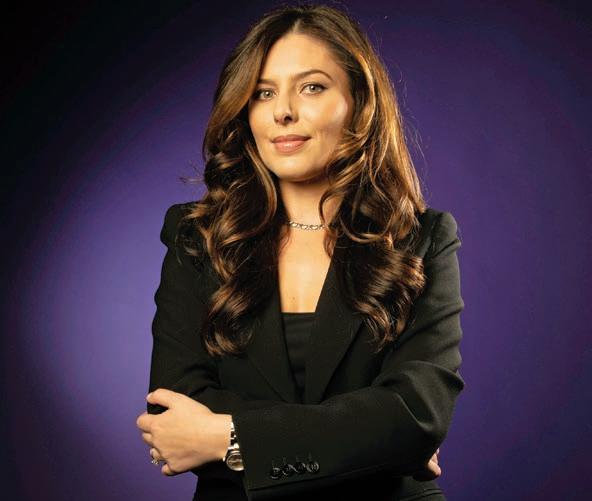

While a student at Yale Law School during the 2008 recession, basha rubin remembers a lot of discussion about the economics of law firms. She and fellow student mirra Levitt began brainstorming about a business that would allow companies to hire the right lawyer at the right price.
“That was the genesis of our idea, which coincided with the rise of consumer marketplaces like Uber and Airbnb,” said rubin.
In 2013 rubin and Levitt co-founded Priori, a legal-tech firm that operates a marketplace to help companies find external legal counsel for typical projects as well as legal talent who could be embedded in a business, providing them a cost savings of 60% to 80%. The midtown-based firm’s name comes from the Latin term a priori, which means “what comes before,” with the idea being that if you hire a lawyer before you have an issue, you save time and money later. Priori has raised over $25 million. Its investors include eagle Proprietary Investments, HearstLab and Thomson reuters. The firm is on the Inc. 5000 list of
fastest-growing companies, with 616% three-year revenue growth. Having launched in rubin’s apartment, Priori now has 50 employees.
rubin found law school intellectually engaging, but she felt she would temperamentally prefer being an entrepreneur. “I wanted to work side by side with people while creating something new,” she said.
Though Priori initially focused on small businesses and individuals, it pivoted in 2016 to serve large enterprises.
“The average Fortune 500 company spends $150 million on outside counsel, and we help reduce cost,” said rubin. A social justice advocate, rubin was a student volunteer for public defenders and political campaigns. Though her spare time is limited now, she is on the board of the brooklyn Debate League, which helps create debate teams in schools.
As for Priori, rubin is gratified that it has enabled lawyers to build flexible careers on their own terms. “We have over 8,000 providers in our network, many of whom are making their entire living through Priori,” she said.
“ I’m learning how to build scaffolds from what I am doing day to day to my ultimate goal and, as a leader of a company, how to inspire and motivate my team to impact that goal.”
Most government officials dread the unexpected. but to molly Schaeffer, emergency response is a reminder of why she entered public service.
“It’s when government, to me, is at its best, because everybody’s incredibly flexible,” she said, “and you can really move these big systems to do things better and faster than ever before.”
Yet Schaeffer, a native brooklynite who now helps lead the city’s response to the migrant crisis, avoids using the word “emergency” to describe the influx of more than 200,000 asylum seekers into the city since 2022. For all its strain on the city’s systems, she said, the crisis has also presented “a great opportunity” to improve the lives of these new arrivals and set them on a path to success.
That was the thrust of the “road Forward” report that Schaeffer authored in march 2023. It recommended training asylum seekers for employment and helping them find permanent housing. It also proposed creating an office to coordinate the whole response — which Schaeffer, then serving as a deputy chief of staff to the mayor, was soon
put in charge of.
The ensuing months have seen many bumps in the road, including costly contracts for migrant care that are being eyed by federal investigators. Schaeffer herself was subpoenaed in September but not accused of any wrongdoing. but the city’s response has also showcased remarkable creativity. New York nearly tripled the size of its shelter system and placed migrants everywhere from cruise ship terminals to office buildings that were converted into housing in a matter of weeks. by September, a help center under Schaeffer’s purview had assisted more than 70,000 migrants with applying for temporary protected status, work authorization and asylum.
Decades from now, Schaeffer predicts, the youngest of these new arrivals will become the next generation of city leaders.
“All the kids that have come over and had these tremendous journeys, they’re going to be the next commissioners,” she said. “That I got to have my fingerprints on that is an incredible feeling.”
“Be flexible — you never know what’s going to come your way. Be open to those new opportunities, and be willing to adjust your perception of how things should work.”


Senior managing director and co-head of New York capital markets, Walker & Dunlop
During the summer of his junior and senior years at the University of Delaware — where he excelled on the tennis court as a four-year letter winner on the men’s team — Jonathan Schwartz learned the bene ts of hard work while interning at the now-defunct bank Eurohypo. He was able to get his hands dirty and focus on learning.
“I was doing whatever the senior folks there told me to do, whether that was get coffee or copy paper or underwrite transactions,” he said. “I got a taste for commercial real estate.”
It was a grind, he said, but it produced great dividends for his future. So much so that when he graduated from college in 2008, during the nancial crisis, he was able to leverage that experience to go work with his dad, a mortgage broker at the rm Cooper-Horowitz. While there, he also rolled up his sleeves and did whatever needed doing.
“I really started on the phones, cold calling owners and operators around the country. That rm is very old school — they gave you a phone book, they gave you some leads, and they said, ‘Go call people and try to do loans,’” he said. “That was the training.”
Schwartz went on to serve as vice chairman and partner in JLL’s New York debt and equity capital markets practice, where he says he helped grow the rm’s revenue by more than 400%. He then moved on to serve as partner at AKS Capital, which he co-founded.
Now 38, Schwartz is the senior managing director and co-head of New York capital markets at real estate nance and advisory services rm Walker & Dunlop, where he’s scored as many aces as he once did on the tennis court. In his four years at the Midtown-based rm, Schwartz has been involved in more than $60 billion in capital market transactions, including nancing, joint-venture equity and loan sale transactions.
“I love the business, and then the other part that I love most is the people. It’s certainly a lot of analysis, but my day is not really spent sitting behind a computer and analyzing numbers. It’s more managing and cultivating relationships and then managing personalities,” Schwartz said. “That is absolutely the highlight of my job.”
— JULIANNE CUBA
“ “
Failure is necessary. I think if you want to do anything great, you have to know what it’s like to not do well.”

Olympic fencer, Team USA

TUltimately, having a really positive outlook and attitude is what you need. Just having a level of perseverance and kind of a no-quit attitude in general is how me and my partners have grown our business. And treat people with a lot of respect, the way you want to be treated, and just be a good, decent person.”
he future of USA fencing could very well be in the hands of a 21-year-old from Queens. Lauren Scruggs, a native of Ozone Park, is coming off a historic summer at the Paris Olympics. After qualifying for her rst Olympic Games, Scruggs took home a silver medal in the individual foil event, making her the rst Black American woman to secure an individual fencing medal. She also played a central role in carrying Team USA to its rst-ever gold medal in the team women’s foil event. Scruggs says what she’ll remember most about her Olympic experience is the epic scale of the fencing venue at the Grand Palais.
“Looking at a crowd like that for fencing was pretty amazing,” she said. “I had never been through something like that before.”
Despite cementing herself as an Olympic champion, Scruggs is staying humble as she returns to Harvard for her senior year to defend her 2023 NCAA title in the individual foil event.
“Fencing is one of those sports where the results don’t really mean much,” she explained. “Obviously, winning a medal is a big deal, but I think fencing is great because anyone can beat anyone. I think I had a really good tournament at the Olympics, but I wouldn’t say I consider myself to be the best fencer in the world.”
When she’s not competing, Scruggs is paying it forward, teaching young New Yorkers how to fence at the Peter Westbrook Foundation in Midtown. For each of the past six years, she has helped to mentor a group of around 20 to 30 kids to master the sport. The foundation provides the service for free. Scruggs says she hopes her increased media attention can help inspire more people like her to get into fencing.
“Hopefully we see more diversity in the sport,” she said, “and I think that’s the trajectory as it stands now.”
Corps de ballet, American Ballet Theatre Artistic director, The Hamptons Dance Project
At age 8, after Jose Sebastian’s first year in dance class at the School of American ballet, he told his mother he wanted to quit.
“If you stay to the end of the year, I’ll buy you a Nintendo,” Pat Sebastian, who adopted her son when he was 2½, recalled telling him. “He never talked about quitting again.”
Her son never did get the Nintendo. but he ended up with a career as a dancer with the American ballet Theatre.
“I was very energetic,” said Jose Sebastian, who grew up on the Upper West Side. “my mom thought it was a good idea to throw me into a ballet class as well as into piano and soccer.” eventually he gave up on the other hobbies and focused on dance.
As his training at the School of American ballet, based in Lincoln Center, became more intense, Sebastian began to think he was pretty good. He recalls wanting to see how far dance could take him.
An AbT summer program in bermuda led to an offer to join the company. He rose to the corps de ballet in 2010,
and since then his repertoire has included featured roles in Paul Taylor’s “Company b,” marcelo Gomes’ “Aftereffect” and Christopher rudd’s “Lifted,” in which he was the lead.
Though a dancer’s workload is heavy, Sebastian found the time to launch The Hamptons Dance Project, which recently completed its sixth summer season of showcasing choreographers and performers in the area of Long Island where mother and son spent many happy times.
“Dance felt underrepresented in the Hamptons,” said Sebastian. Although AbT offers the organization advice, all funding comes from the dance project’s donors.
“Instead of starting like a grassroots company, we thought, let’s jump into this big,” he said. “The first year we had a six-figure budget, and it’s been going up and up.”
Sebastian maintains his desire to expand opportunities for other dancers, and he also wants to keep adding to his own resume.
“I look forward to more challenging leading roles,” he said.
— LoU HArrY

“ In the arts, ‘no’ doesn’t necessarily mean no. It means you might have to work a little harder, and it might take a little longer.”
ick e. Smith had early success as a student at the University of California-berkeley. He gained a seat on the city Labor Commission at age 18, became chairman at 20 and helped pass a city ordinance against procuring goods made in sweatshops.
So when he received his law degree from St. John’s University, Smith figured his education and experience would help him quickly find a perch in New York City writing legislation on behalf of workers, housing and criminal justice.
Things did not quite go as planned. He spent 18 months applying to the offices of City Council members and state legislators. on the side, he wrote website copy for $15 a story.
“This is the part where I became concerned about my future,” he said. “They all said, ‘Your resume’s amazing, but you’re not from New York. I can’t hire you to be my policy director.’”
He had bought a plane ticket back to his native Los Angeles when Upper West Side Assemblywoman Linda rosenthal called with an offer to join her team.
Smith later became the policy director for then-Councilman Jumaane Williams, a role in which Smith authored or co-authored more than 50 city laws. He served as a legislative aide in the de blasio administration and then as first deputy public advocate to Williams, now the city’s public advocate. Smith left the post in June to pursue housing legal services and advocacy as the executive director of Communities resist, or Core.
Williams did not want him to leave. “For me it was about expanding my toolkit, advancing my career … and growing,” Smith said.
brooklyn-based Core focuses on low-income tenants in rapidly gentrifying neighborhoods, going beyond representation in housing court to organize communities to advocate for themselves. According to its website, the organization has stopped 837 evictions.
Smith, who is a twin, has twin daughters, Grace and Faith, and the family lives in Harlem. His twin sister, Nichole, also has twin girls.
“I believe and believed in the phrase that if you can make it in New York City, you can make it anywhere in the country,” Smith said.

Co-founder and chief creative officer, Madwell
Chris Sojka, co-founder and chief creative officer of the brooklyn- and Denver-based creative agency madwell, thinks the creative services profession can be rife with fear about doing things “the right way.” In his view, there is no one right way — and chasing it is a fool’s errand. Instead, he sees creative work as compiling a bunch of ideas into “a beautiful Frankenstein” monster.
“The job of a creative agency is to bring together and make seamless an assemblage,” he said. “If you believe in your ideas enough to believe that other people’s ideas can actually live with your ideas, you stop worrying about whether you are right or wrong. You can use your whole brain and have fun and build that living creature.”
Since 2010, his company, which now has about 125 employees and in 2023 generated between $28 million and $29 million in revenue, has assembled campaigns for companies and products as varied as Google, the TCS New York City marathon, Heineken and Clif bar, while madwell’s sibling company, bankrobber, has created a “Squid Game” pop-up event for Netflix and done work in partnership with black Lives matter.
“Grab ’em by the heart. Punch ’em in the brains,” philosophized Sojka. “[Consumers] need to feel stuff first.” And that means tearing down the walls between traditional platforms. “Digital is the denominator,” he said. “It connects everything. It’s not another pillar.”
When the phone service visible wanted to get some visibility during the pandemic, madwell created “red rocks Unpaused,” a branded hybrid of live and virtual experiences that attracted more than 8 million viewers and 2.5 billion in earned media impressions.
Through madwell, Sojka and company launched a record label, Tiny Giant Sounds, and directed a music video starring Charlotte rose benjamin in a zero-gravity plane for cosmetics company client e.l.f. A multiartist album, “Gr Wm,” dropped oct. 15, all serving to launch e.l.f.’s entertainment wing.
“It may not seem to be advertising anything, but brands like e.l.f. are … a character in the narrative of life,” Sojka said. “We can bring joy and get to the advertising later.” besides, he added, “commercials can be transient. I want to make stuff that lasts.”
— LoU HArrY

“ There are a nearly infinite number of ways to do something well and only one way to fail — and that is to not do it.”
Associate, Bryan Cave Leighton Paisner
As a child in a Coast Guard family, Kurt Steinhouse had the extraordinary privilege of living for a couple of years on the 22-acre Governors Island. He remembers gazing up at the skyscrapers of Manhattan from the family’s dining room window.
Now as an associate in the U.S. planning and zoning practice of the law firm Bryan Cave Leighton Paisner, Steinhouse influences what that trillion-dollar skyline looks like. He focuses his work on all aspects of land use, zoning and real estate development in New York City. Notably, he is on the litigation counsel team that represents Empire State Development and has successfully defended the state at the trial court level against community opposition to its plans to construct 10 mixed-use towers around a renovated Penn Station, the busiest transit hub in the Western Hemisphere. Once completed, the 18 million-square-foot project would be the largest real estate development on the continent and take up the bulk of the reportedly $22 billion projected total cost for the redevelopment plan.
Steinhouse arrived at BCLP in 2022 with deep insider knowledge of the city’s land-use agencies garnered from more than eight years in public service for the city, first working as assistant general counsel for the Department of Buildings, then as general counsel for the Board of Standards and Appeals, where he advised the government but also attended numerous public hearings and had direct contact with city residents.
He is committed to public service and offered pro bono zoning counsel in matters related to the June 2024 opening of the Stonewall National Monument Visitor Center. Historically known as the birthplace of the gay-rights movement, the Stonewall Inn in Greenwich Village is now the first site in the National Park Service dedicated to LGBTQ+ history.
A Manhattan resident, Steinhouse sees that as he advises his clients about billions of dollars’ worth of real estate development, he is also serving his fellow New Yorkers. “Being real estate-focused in New York City is so exciting,” he said, “because I can help provide nice amenities and improve the quality of life in this town.”
— JEANHEE KIM


Principal, Karp Strategies
“ Maintaining
a sense of curiosity is incredibly important. I love drilling into details, keeping an open mind.
By not having preset conclusions, I can come to interesting results.”
Though originally from Canada, Alexandra Sutherland-Brown has long felt she was meant to be a New Yorker.
“I always knew that this is where I needed to be,” she said, “and I wanted to find a job or figure out how to live in and also very much contribute to New York.”
After graduating from Princeton with a bachelor’s degree in history and American studies, she moved in 2008 to Manhattan, where she lived just a few blocks from the then-novel High Line.
“I got to experience it in those magical few months before it was taken over by tourists,” she said.
She fell in love with the park’s energy and all the moving parts that culminated in its management, so she decided to pursue a career path that would marry her appreciation for the city with her interest in history. She got her master’s in city planning from MIT, and then upon graduation, worked for the city’s Department of City Planning and what’s now called the Urban Design Forum.
Now 38, Sutherland-Brown leads Karp Strategies’ economic development practice. The firm’s first-ever hire, as an associate in 2016, Sutherland-Brown has helped Karp grow internally — the company has doubled in size in the past few years — and in influence.
“ Anybody can learn the content. But success really at any level in your career boils down to management and communication, because that's how you work successfully with other people.”
As principal, she has led or advised clients on projects that help to create healthier and more equitable communities, including the Port Master Plan for the Port Authority of New York and New Jersey and the award-winning redesign of Brooklyn Public Library’s Brownsville branch. And, she says, she has helped various municipalities and companies receive over $500 million in funding for capital projects.
Sutherland-Brown’s days at her office in the Financial District are split among business development, project management and making sure that clients are happy with the work she and her team are doing. Currently her to-do list includes projects involving health care retention and a corridor revitalization in the South Bronx.
“The unifying theme across what we do is putting people first,” she said.
Bhav Tibrewal developed his political consciousness at a young age. Raised in the predominantly white suburbs of Long Island and New Jersey by parents who had emigrated from India, he grew up “angsty and a little angry at my experiences, my parents’ experiences.”
But the “rah-rah” style of activist politics, though an important part of any movement, didn’t suit Tibrewal’s temperament. It wasn’t until his rst job out of college, as a researcher for the labor union Unite Here, that he “fell in love with strategy” and saw how it could bene t workers.
“The rah-rah tactics are going to come in at the right points, but there’s a bigger vision,” he said. “If we’re doing our jobs right, we’re not just bumbling up to a ght and yelling outside a building. Leading up to that point, you’re planning for war in peacetime.”
Tibrewal developed a philosophy for organizing based on the idea that powerful people must be given a reason to support a cause. To win over politicians, an organizer must understand that they sometimes care more about keeping up appearances in their districts than getting
behind a worthy piece of legislation.
In 2015 Tibrewal became deputy political director for the powerful Hotel Trades Council, which represents hotel workers; he was promoted to political director in 2020. Prior political directors at HTC, known as a savvy union, had helped severely curtail Airbnb and crowned City Council speakers.
Tibrewal picked up where they left off, helping secure the 2021 city law that limited the construction of new hotels and the 2022 state law that will authorize casinos in New York City. (HTC, which now represents casino workers, changed its name to include “Gaming” that year.)
He’s especially proud of his work securing the 2021 Tourism Worker Recovery Fund: a $100 million package that gave payments of $2,750 each to hospitality workers left reeling by the pandemic.
With a mayoral election and a casino sweepstakes on the horizon, Tibrewal and HTC will be calling many of the shots.
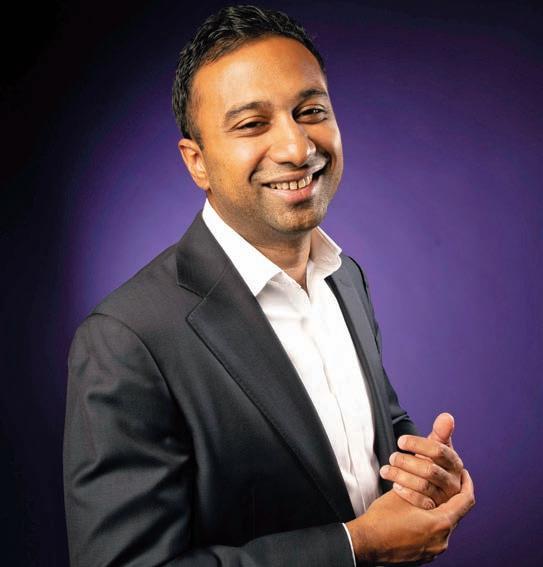
In 2012 Matt Weinberg was a new college graduate with a job on President Barack Obama’s re-election campaign and a dorky job title: head of of ine merchandise sales.
“Every bumper sticker, T-shirt, yard sign, mug, that was all my department,” he said. “Not the most glamorous job, but it was a multimillion-dollar enterprise.”
The role gave him real-world experience with supply chains, inventory management, labor negotiations and pro t margins. He spent hours with an army of interns reconciling accounts to ensure swag sales complied with federal election laws.
“
He heeded New York’s siren call after the election and took a role at the city Economic Development Corp., where he worked on Mayor Bill de Blasio’s initiatives to help startups. He managed citywide programs aimed at developing and supporting the city’s technology and entrepreneurial ecosystems.

The redevelopment of JFK International Airport is a project funneling $20 billion worth of contracts to designers, engineers and construction workers.
Francilia Wilkins Rahim makes sure some of that money ows to women- and minority-owned business enterprises that haven’t gotten it before.
“You can train them to death, but until you give them a contract, this is all kind of just BS exercises,” she said. Wilkins Rahim is a compliance consultant to the Port Authority of New York and New Jersey. Her job is to make sure the agency lives up to its pledge to allocate about a third of the JFK reconstruction budget to MWBEs. She said she’s helped the Port “leverage” federal and state law to award contracts of as little as $1 million.
“That’s a small amount for the government,” she said, “and a life-changing sum for a small business.”
Wilkins Rahim and her family ed the civil war in their
“
that career path. He got his MBA at Columbia Business School and emerged as a venture capital investor. Now he’s a partner at Max Ventures, which specializes in providing seed funding to the smallest of startups. The rm has invested $100 million in about 80 companies and helped start eight others.
Business relationships require a thoughtful approach—one that is genuine, honest and not transactional.”
He set his sights on working again in Washington, but the election of President Donald Trump derailed
native Liberia when she was 3. At her Rhode Island high school, she organized a citywide basketball tournament, complete with ticket sales, concessions and security.
She looked for a job in consulting after graduating from St. John’s University and ultimately decided to become an independent contractor, helping nonpro ts nd money to operate shelters and other services. She estimates she’s assisted clients in raising $900 million over the last decade. A staff of 30 works at RF Wilkins Consultants, the rm she named for her mother.
But this is just the start. Wilkins Rahim has leased 40,000 square feet at the Brooklyn Navy Yard and plans to soon launch a 150-employee contract manufacturing rm that would make cosmetics for big brands in search of new customers. She plans to name this business for her father, whose nickname was Ayo.
— AARON ELSTEIN
When someone says they don’t think you can do something, nd a way to make that motivating.”
Having mastered presidential-campaign supply management, he’s now interested in another politically intensive arena: health care. At Max Ventures, he co-founded the health care technology research marketplace Elion Health, which has gone on to raise millions of dollars from top venture capital rms.
Venture capital rms have to take chances, but Weinberg says his varied experience gives him some idea of how realistic an entrepreneur’s dreams are.
“As company builders, it makes us better investors because we know what it’s like driving a car and understanding how the engine works versus just being a driver,” he said.

By Nick Garber
The city plans to tear down an aging market building in the Meatpacking District and replace it with a large new housing development and space to expand the next-door High Line and Whitney Museum of American Art, officials announced Oct. 28.
The 66,000-square-foot Gansevoort Meat Market has stood for nearly a century at the corner of 10th Avenue and West 12th Street, an increasingly visible outlier in a neighborhood that has mostly shed its industrial past. The market’s operators had already been searching for a new facility with more up-to-date technologies, and Mayor Eric Adams’ administration said Oct. 28 that the operators had agreed to end their lease early on the city-owned site.
In its place, the city aims to permit as many as 600 housing units — half of which could be affordable — as well as 11,200 square feet of public open space. The Whitney, which abuts the market, has a right of first offer to build on the remaining 45,000-square-foot

well-regarded first deputy mayor has headlined in recent weeks, helping to calm the private sector in the wake of Adams’ indictment.
Adams pledged in his January State of the City speech to advance plans for housing on 24 city-owned sites. The city negotiated with the market’s operators, the co-op Gansevoort Market Inc., in the ensuing months and reached a deal in August. John Jobbagy, the co-op’s president, said in a statement that the operators had spent “the last decade” searching for new facilities.
Mayor Eric Adams aims to replace the Gansevoort Meat Market with 600 apartments and cultural space.
space within the site, and the museum’s director confirmed that it is already in talks with city officials.
The city plans to consult with the local community board starting in November and then release a request for proposals, with a developer expected to be chosen in 2025, First Deputy Mayor Maria Torres-Springer said at an Association for a Better New York event on Oct. 28.
“This is the exact type of project New Yorkers want our city to continue to dream up and deliver,” Torres-Springer told an audience of business leaders and lobbyists — one of several such events that the
“Many of our members are multigenerational family businesses, employing hundreds of dedicated New Yorkers who serve our city’s restaurants and stores,” he said.
“With technological advances, our industry processing practices have changed, and the market building does not meet up-todate standards for processing and distribution.”
No public subsidy will be needed to finance the future affordable units, and the potential expansions by the Whitney and High Line would be privately financed, Torres-Springer said. But the housing development would need to move through a monthslong public review, which will give in-
fluence to local City Council member Erik Bottcher — who said Oct. 28 that he was “excited” by the potential project.
The potential Whitney expansion could include new gallery and education spaces, complementing the Renzo Piano-designed main building that opened next to the High Line in 2015. The existing museum has 50,000 square feet of gallery space, so the new development could roughly double its current size.
Scott Rothkopf, the museum’s director, said the Whitney is “engaged in promising talks with the city and Friends of the High Line about a unique opportunity to expand onto a neighboring city-owned site, which would allow us to better serve artists and audiences from New York and around the world.”
The Whitney gained its right of first offer to expand onto the Meat Market site as part of its 2009 deal with the city that paved the way for its current home.
Alan van Capelle, executive director of Friends of the High Line, said his organization is in “early conversations” about its own expansion, which could help the park accommodate its growing number of visitors.


By Aaron Elstein
The busiest shopper in SoHo these days is a little-known real estate investor who snapped up the building at 92-94 Greene St. for $43 million last month. It was the eighth acquisition on Greene and 12th in the tony neighborhood for Westchester County-based Acadia Realty Trust. Acadia, which has been buying and selling retail properties for more than 30 years, is one of several investors rediscovering the joys of storefronts. In an effort to lessen its reliance on office-rental revenue, Empire State Realty Trust recently started buying retail spaces on Williamsburg’s pricey North 6th Street.
Wall Street likes the sound of that and bid up shares in Acadia to $24 each, their highest level since January 2020.
One reason Acadia is so enthusiastic about SoHo, the West Village and Williamsburg is that other cities in its portfolio aren’t doing so well.
For the third quarter Acadia reported $33 million in funds from operations, up from about $27 million in the prior-year period.
Acadia, whose 5 million squarefoot portfolio nationwide makes it about half the size of Empire State Realty, began buying in Williamsburg two years ago and last month bought 123-129 N. Sixth St. for $18 million. It also recently acquired four buildings on Bleecker Street for $20 million, part of a $120 million shopping spree this year in New York and other cities. Officials say another $150 million in acquisitions is to come, and they plan to take investment positions in another $275 million worth of properties.
“Conditions have finally begun to shift,” Chief Executive Ken Bernstein said on an earnings call Oct. 28. “This has enabled us to move to offense and allowed us to amplify our focus on street retail properties in key must-have, high-growth markets.”
Chicago, where the firm owns nearly twice as much as in New York, is a notable sore point. The occupancy rate for Acadia-owned properties in downtown Chicago and posh neighborhoods to the north, at 82%, is almost 10 percentage points below New York. Bernstein said on the call that leasing demand is increasing. Acadia had no immediate reply to a request for comment. Altogether, in-place occupancy came in at 85.6% in the third quarter for street and urban properties described by Acadia as core, down from 88.0% in the year-earlier period.
“Core data points were a little mixed,” JPMorgan analysts said in a note to clients.
Before making its latest acquisitions, in May Acadia sold 95% of its stake in the Shops at Grand, an Elmhurst, Queens shopping center whose tenants include a Stop & Shop and Party City. The firm disclosed it took a $2 million loss on the $50 million sale.
For the third quarter Acadia reported $33 million in funds from operations, up from about $27 million in the prior-year period. Even better times lie ahead, Bernstein said, as the firm buys more in the city’s most glorious commercial corridors. He noted that rents charged at its newest Greene Street property are “substantially below market.” The retail space is occupied by French luxury retailer Givenchy.













ResearchbyDavidNusbaum(david.nusbaum@crain.com).Toqualifyforthislist,organizationsmustbetax-exempt501(c)(3)nonprofitswithheadquartersintheNewYorkarea.ThisincludesNewYork CityandNassau,SuffolkandWestchestercountiesinNewYork,andBergen,Essex,HudsonandUnioncountiesinNewJersey. Crain'sNewYorkBusiness usesstaffresearch,extensivesurveysandthe mostcurrentreferencesavailabletoproduceitslists,butthereisnoguaranteethatthelistingsarecomplete.Universities,colleges,libraries,hospitals,healthcareinstitutions,medicalpracticegroups andresearchinstitutionsareexcluded.Informationisfromtheorganizations,websites,Forms990andfinancialstatements. 1. Containsfiguresfromtwoaffiliated990s. 2. 2022dataismostrecent available. 3. Includes data from 990s for two affiliated organizations. 4. Served as interim president and chief executive until July 2023. See much more at crainsnewyork.com/data
ResearchbyDavidNusbaum(david.nusbaum@crain.com).Toqualifyforthislist,organizationsmustbeheadquarteredintheNewYorkarea,whichincludesNewYorkCityandNassau,Suffolkand WestchestercountiesinNewYork,andBergen,Essex,HudsonandUnioncountiesinNewJersey. Crain'sNewYorkBusiness usesstaffresearch,surveysandthemostcurrentreferencesavailableto produceitslists,butthereisnoguaranteethatthelistingsarecomplete.Informationisfromtheorganizationwebsites,forms990andauditedfinancialstatements. 1. Foundationestimate. 2. Theaward wasmadein2019for$140millionwith$20millionpaidin2023. 3. 2022dataismostrecentavailable. 4. Annualpaymentona$50millioncommitment. 5. IncludestheWilliamRandolphHearstFoundation and The Hearst Foundations. 2022 data is most recent available. See much more at crainsnewyork.com/data
The New York Racing Association, Inc. (“NYRA”) is soliciting bids from qualified vendors to provide a comprehensive turn-key Cellular Distributed Antenna System (“DAS”) at the new Belmont Park Racetrack located in Elmont , New York, USA. The resulting project will be owned and operated by NYRA. Please be advised that the Authorized Contact Person for all matters concerning this RFP is Allan Howell EMail:ahowell@nyrainc.com
The bid document, including specifications and requirements, may be obtained via an email to procurement@nyrainc.com¬ or please register as a vendor on NYRA’s bidding portal at no cost. www.bidnetdirect.com/new-york/nyra.
The New York Racing Association, Inc. (“NYRA”) is soliciting bids from qualified vendors to provide a comprehensive turn-key Wireless Network System at the new Belmont Park Racetrack located in Elmont , New York, USA. The resulting project will be owned and operated by NYRA. Please be advised that the Authorized Contact Person for all matters concerning this RFP is Allan Howell EMail:ahowell@nyrainc.com
The bid document, including specifications and requirements, may be obtained via an email to procurement@nyrainc.com¬ or please register as a vendor on NYRA’s bidding portal at no cost. www.bidnetdirect.com/new-york/nyra.
Notice of Qualification of VERBITSKY CAPITAL LLC
Appl. for Auth. filed with Secy. of State of NY (SSNY) on 10/08/24. Office location: NY County. LLC formed in Delaware (DE) on 10/03/24. Princ. office of LLC: 300 Central Park West, Apt. 3K, NY, NY 10024. SSNY designated as agent of LLC upon whom process against it may be served. SSNY shall mail process to the LLC at the princ. office of the LLC. DE addr. of LLC: 251 Little Falls Dr., Wilmington, DE 19808. Cert. of Form. filed with Secy. of State of the State of DE, John G. Townsend Bldg., 401 Federal St., Ste. 4, Dover, DE 19901. Purpose: Any lawful activity.
Notice of Formation of LP PRESERVATION DEVELOPER
LLC Arts. of Org. filed with Secy. of State of NY (SSNY) on 10/25/24. Office location: NY County. Princ. office of LLC: 116 E. 27th St., 11th Fl., NY, NY 10016. SSNY designated as agent of LLC upon whom process against it may be served. SSNY shall mail process to Corporation Service Co., 80 State St., Albany, NY 12207. Purpose: Real Estate Investment & Development
Notice of Qualification of LEVEL STRUCTURED CAPITAL III, L.P. Appl. for Auth. filed with Secy. of State of NY (SSNY) on 09/05/24. Office location: NY County. LP formed in Delaware (DE) on 08/30/24. Princ. office of LP: 140 E. 45th St., NY, NY 10020. Duration of LP is Perpetual. SSNY designated as agent of LP upon whom process against it may be served. SSNY shall mail process to c/o Corporation Service Co. (CSC), 80 State St., Albany, NY 12207-2543. Name and addr. of each general partner are available from SSNY. DE addr. of LP: CSC, 251 Little Falls Dr., Wilmington, DE 19808. Cert. of LP filed with Secy. of State of the State of DE, Div. of Corps., John G. Townsend Bldg., 401 Federal St., Ste. 4, Dover, DE 19901. Purpose: Investments.
VINEA LLC Arts of Org. filed SSNY 7/29/2024 New York Co. SSNY design agent for process & shall mail to 45 W 76th Street Apt 1B, NEW YORK, NY, 10023 RA: US CORP AGENTS, INC. 7014 13TH AVE, SUITE 202, BROOKLYN, NY, 11228 General Purpose
CAMILLE GALLO, LLC Arts of Org filed with Secy of State of NY (SSNY) on 2/29/24. Office Location: New York County. SSNY designated as agent upon whom process may be served against LLC to: Camille Gallo, 66 Madison Ave,Ste 8C, NY, NY, 10016, USA, CamilleGallo@Live.com Purpose: any lawful act.
Notice of Formation of FORCE MAJEURE LIFESTYLE, LLC Arts of Org filed with Secy of State of NY (SSNY) on 9/3/24. Office Location: NY County. SSNY designated as agent upon who process shall be served and shall mail copy of process against LLC, to PO BOX 89, DARRIEN, CT, 06820, USA
Purpose: any lawful act.
BLUEFISH APPAREL LLC. Arts. of Org. filed with the SSNY on 08/22/24. Office: New York County. SSNY designated as agent of the LLC upon whom process against it may be served. SSNY shall mail copy of process to the LLC, 34 West 33rd Street, 7th Floor, New York, NY 10001. Purpose: Any lawful purpose.
PLLC Arts of Org filed with Secy of State of NY (SSNY) on 7/24/24. Office Location: NY County. SSNY designated as agent upon who process shall be served and shall mail copy of process against THE LLC, to 205 E. HIGH ST.. CHARLOTTESVILLE, VA, 22902.. Purpose: any lawful act.
HSH MANHATTAN LLC. Arts. of Org. filed with the SSNY on 09/18/24. Office: New York County. SSNY designated as agent of the LLC upon whom process against it may be served. SSNY shall mail copy of process to the LLC, c/o Marcum LLP, 730 Third Avenue, 11th Floor, New York, NY 10017. Purpose: Any lawful purpose.
Notice of Formation of LL MAD IRON LLC Arts. of Org. filed with Secy. of State of NY (SSNY) on 10/10/24. Office location: NY County. SSNY designated as agent of LLC upon whom process against it may be served. SSNY shall mail process to c/o Farrell Fritz, P.C., 400 RXR Plaza, Uniondale, NY 11556. Purpose: Any lawful activity
DIA NATURAL STONE LLC Arts of Org. filed SSNY 10/01/2024 New York Co. SSNY design agent for process & shall mail to THE LLC 368 9th Ave, WEWORK C/O KEREM SAZ, NY, NY 10001 RA: US CORP AGENTS, INC. 7014 13TH AVE, STE 202, BROOKLYN, NY, 11228 General Purpose
Notice of Qualification of 50 HST HOSPITALITY LLC Appl. for Auth. filed with Secy. of State of NY (SSNY) on 10/23/24. Office location: NY County. LLC formed in Delaware (DE) on 08/19/24. Princ. office of LLC: 183 Centre St., 6th Fl., NY, NY 10013. SSNY designated as agent of LLC upon whom process against it may be served. SSNY shall mail process to Corporation Service Co., 80 State St., Albany, NY 12207-2543. DE addr. of LLC: 251 Little Falls Dr., Wilmington, DE 19808. Cert. of Form. filed with Secy. of State, 401 Federal St., Ste. 4, Dover, DE 19901. Purpose: Any lawful activity.
Notice of Qualification of CADIAN SOFTWARE GP, LLC Appl. for Auth. filed with Secy. of State of NY (SSNY) on 10/23/24. Office location: NY County. LLC formed in Delaware (DE) on 09/25/24. SSNY designated as agent of LLC upon whom process against it may be served. SSNY shall mail process to Corporation Service Co. (CSC), 80 State St., Albany, NY 12207-2543. DE addr. of LLC: CSC, 251 Little Falls Dr., Wilmington, DE 19808. Cert. of Form. filed with Secy. of State of DE, Div. of Corps., The John G. Townsend Bldg., PO Box 898, Dover, DE 19903. Purpose: Any lawful activity
Notice of Formation of 200 E 69TH STREET APT. 25B
LLC Arts. of Org. filed with Secy. of State of NY (SSNY) on 09/10/24. Office location: NY County. Princ. office of LLC: c/o Melissa E. Sydney, Esq., Tarlow, Breed, Hart & Rodgers, P.C., 101 Huntington Ave., Ste. 500, Boston, MA 02199. SSNY designated as agent of LLC upon whom process against it may be served. SSNY shall mail process to Corporation Service Co., 80 State St., Albany, NY 12207-2543. Purpose: Any lawful activity.
By Aaron Elstein
A judge ordered RFR Holding to hand over the Chrysler Building after the embattled developer fell behind on $21 million in rent to Cooper Union.
e school, which owns the ground underneath the landmarked tower, in September terminated RFR’s lease to operate the building. When RFR refused to leave, Cooper Union asked a judge to eject the rm from the premises and hand it the keys. At a hearing Oct. 31, New York state Judge Jennifer Schecter ruled that, as of Nov.
the school looks forward to working with Cushman & Wake eld and other advisers to manage the Midtown landmark.
RFR described its removal from the Chrysler Building as temporary and said the judge’s decision would halt a multi-hundred-million dollar restoration, which is “a tremendous loss for New York City.”
“In terms of any defenses, I haven’t heard any that have merit.”
Jennifer Schecter, New York state judge
1, Cooper Union is running the Chrysler Building.
“In terms of any defenses, I haven’t heard any that have merit,” Judge Schecter said.
Cooper Union said the judge “clearly agreed that we were in our rights to terminate the lease,” and
RFR has operated the Chrysler Building since 2019 in return for paying Cooper Union $32 million in annual ground rent. e rm, run by Aby Rosen, owns 3 million square feet of space, including the Seagram Building at 375 Park Ave., but several properties are struggling during a rough year.
RFR fell behind on rent for the Chrysler four months ago and even stopped paying Con Edison bills, according to court documents. e developer alleged in a lawsuit that tenants refused to lease space because they were upset with how Cooper Union handled student unrest last year on its campus downtown

next to Astor Place. But Judge Schecter said RFR was still responsible for paying rent to the Chrysler’s landlord and urged the adversaries to resolve their di erences.
A lawyer for RFR said that would
be di cult.
“Cooper Union is now controlling the building, getting the rent, managing the building,” said the attorney, Aaron Solomon. “I know your honor ended the order

with, we should all try to resolve this. How can we do that? What is left to try and resolve?”
“Well,” Judge Schecter said, “there’s a lot of money that’s owed here.”


By Ethan Geringer-Sameth
New York hospitals are increasingly automating pharmacy functions to free up staff and improve the accuracy and safety of dispensing medicine.
They have embraced robots to store, catalog and fill medications as administrators seek more efficiencies and less human error. The technology is costly and does not always result in staffing reductions, but what it sometimes lacks in direct savings it makes up for in higher quality services and less burden on staff, top pharmacists said.
The latest new tech is going to Maimonides Medical Center, which recently filed to replace its old drug-dispensing robot with two new ones for $8.1 million. A vast majority of medications for patients admitted to Maimonides — roughly 80% — are dispensed by a robot, according to the system’s director of pharmacy and assistant vice president of pharmaceutical services Dr. Jason Brady. The new machinery will come with a 1,000-square-foot renovation of the facility’s pharmacy, according to a filing with the state. Here’s how it works: A computer sends an order for meds to the robot, which measures them out and drops them into an envelope. A
technician picks up the dispensed medication, which is verified by a pharmacist before it is delivered to the nursing unit to be administered to the patient. At every step of the way, a barcode is scanned to ensure the packets' contents and trajectory.
Major hospital systems around the city have adopted similar systems.
New York-Presbyterian has pharmacy robots in its Queens and Brooklyn Methodist hospitals that spit out medications like a vending machine, said Vice President and Apothecary-in-Chief Dr. Patrice Dupart. Technicians are still needed to fill the robot, an approximately 16-foot cabinet with mechanical arms and fingers, and deliver them to nurses, she said.
The technology improves the quality and safety of drug delivery and frees up staff time for more clinical work, said Dr. Susan Mashni, chief pharmacy officer and senior vice president of pharmacy services at Mount Sinai Health System, which uses robots to dispense common drugs and more specialty — and caustic — medicines like chemotherapy treatments.
“It’s somewhat of a breakeven

because it takes staff to actually man the machine,” she said. But it does help meet regulations around cleanliness and exposure and reduces the wear on technicians.
Injuries from repetitive acts, like filling a pill bottle, were not uncommon in the pharmacy before many of the functions were automated, Mashni said. Even more risky was the preparation
and transfer of radioactive chemicals used in oncology.
“Gone are the days where chemotherapy or infusions are getting made at the bedside,” she said.
The shift towards pharmacy automation has unfolded over the past decade in New York. SBH Health System renovated its pharmacy in 2011 for $20 million to focus on adding emerging robotic
tech, said Senior Vice President of Clinical Support Services and Chief Pharmacy Officer Dr. Ruth Cassidy. Now, robotics are heavily integrated into SBH Health System’s pharmacy from automated dispensing to a machine that prepares IV bags. The move has allowed the system to redeploy staff, shifting at least five pharmacists from the dispensing floor to a new clinical department, she said.
Partnership for New York City, describing the last two years of state politics.
Hochul and other New York Democrats performed below expectations in 2022, and the governor is known to still be smarting from then-Speaker Nancy Pelosi’s public claim that Hochul’s electoral weakness had been a drag on down-ballot Democrats.
Determined to avoid the same fate in 2024, Democrats won a court ruling late last year allowing them to redraw congressional districts that had given the GOP a leg up — and ultimately produced a new set of maps that modestly bene t Democratic candidates.
Separately, Democrats have pushed a state constitutional amendment protecting abortion rights in hopes of driving turnout among the party’s base.
Most notably, Hochul has helped revitalize the moribund state Democratic Party. A “coordinated campaign” led by the governor, House minority leader Hakeem Je ries and Sen. Kirsten Gillibrand has raised millions of dollars to support Democratic House candidates and created a structure that could exert in uence in the years ahead.
“It’s truly extraordinary and unprecedented that New York has the same kind of coordinated campaign that is traditionally seen in other states, where labor, community stakeholders and candidates up and down the ballot are all working together for a common goal,” said Evan Stavisky, a Democratic strategist, who also noted the potential bene ts for Hochul’s own re-election bid. “It seems safe to say that the e orts this year will not only pay dividends this year but in two years at the next gubernatorial election.”
e biggest casualty of the election may be congestion pricing — although Hochul has insisted that her “pause” was both temporary and unrelated to any fears that the Manhattan tolling program might harm suburban Democrats. Multiple reports have cast doubt on that claim, and Je ries, whose potential speakership rides on Democratic success in New York, was noticeably quick to praise Hochul’s June turnabout.
e governor has been more direct about how electoral concerns reduced the state’s housing ambitions, after her 2023 Housing Compact caused an uproar in some parts of Long Island and the Hudson Valley. Nearly a year ago,

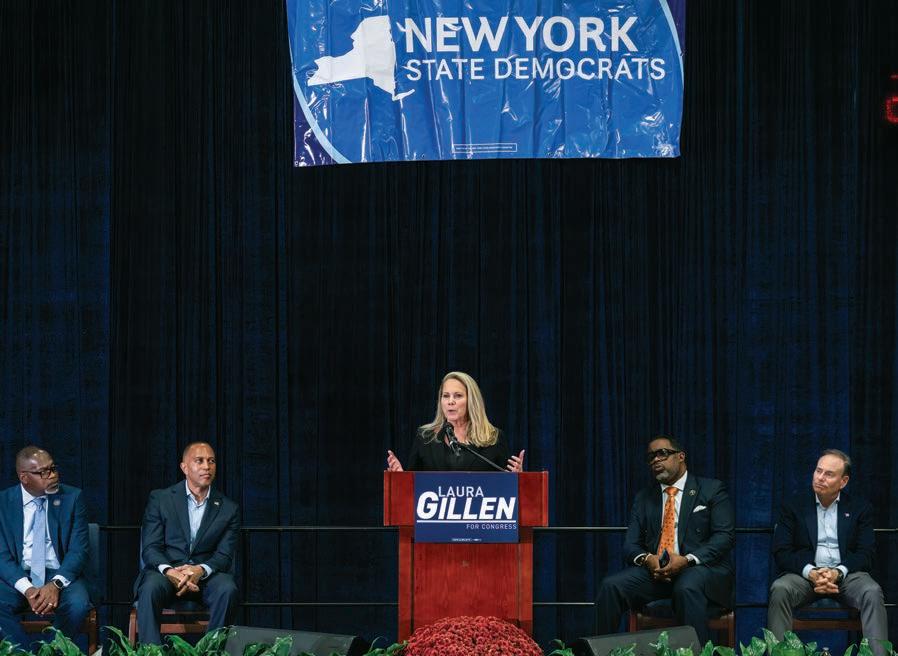
Hochul announced she would not pursue statewide growth mandates again in 2024, anticipating that state lawmakers would be hesitant to sign on in “an election year.” ( e more limited housing deal that lawmakers did reach this year included tax
“It seems safe to say that the efforts this year will not only pay dividends this year but in two years at the next gubernatorial election.”
Evan Stavisky, Democratic strategist
incentives and tenant protections that have not emerged as campaign issues.)
It’s unclear whether either policy will be revived after Nov. 5. To shore up the MTA’s nances, Hochul has suggested she will propose a replacement for congestion pricing after Election Day — but any new tolls would be a nonstarter if Donald Trump is elected president. And Hochul has her own reasons to be wary of taking a big wing on housing again in 2025, with her re-election looming in 2026.
Hochul’s approval rating remains underwater, fueling speculation about her potential vulnerabilities in either a primary or general election in 2026. But local leaders are pleased with her in-
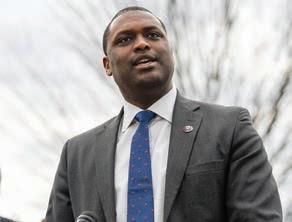
creased attention to the state party, which had su ered years of relative neglect under Andrew Cuomo.
“Historically, pre-Hochul, governors maintained their distance from these races, lest they look weak politically if it doesn’t work out,” said one Albany lobbyist. “It takes some balls to so closely associate with the congressional races and put skin in the game.”
About two million voters in six congressional districts will decide whether all the maneuvering by state Democrats has been worth it. ose contests, concentrated in the Hudson Valley and Long Island, have been dominated by issues like immigration, abortion rights and taxes.
In the 1st District, on the East End of Long Island, Democrat John Avlon — a former journalist and CNN anchor — is challenging incumbent Republican Nick LaLota. LaLota, a former county o cial, won his seat by 11 points in 2022, continuing the region’s rightward drift. But Avlon has attracted notice thanks to his high pro le, proli c fundraising and centrist image. A mid-October Siena College poll showed LaLota ahead narrowly, 47%-44%.
e 4th District on Long Island’s South Shore is seen as a prime pickup opportunity for Democrats, after Republicans themselves ipped it two years ago — contributing to their fourseat gain in 2022. Incumbent Republican Anthony D’Esposito, a former NYPD detective and Long Island legislator, has a rematch with Democrat Laura Gillen, a former Hempstead Town supervisor.
D’Esposito’s win two years ago was narrow, and his re-election bid was complicated further by a September New York Times report that he had given government jobs to both his mistress and his ancée’s daughter. A Siena poll released Oct. 22 showed Gillen
with a surprising 12-point lead.
Up in Westchester and Rockland counties, the 17th District race pits incumbent Republican Mike Lawler against former Democratic Congressman Mondaire Jones. e contest has been particularly strange: Jones previously abandoned the district amid the chaos of New York’s 2022 redistricting process and ran unsuccessfully in New York City, only to return to his old Hudson Valley territory this year. And a little-known candidate managed to beat Jones out for the third-party Working Families Party ballot line, in what is widely perceived as a Republican-driven e ort to divert votes from the Democrat.
Lawler, who notably unseated powerful House Democrat Sean Patrick Maloney two years ago, is widely expected to run for governor in 2026 if he can hang onto his seat this year.
e neighboring 18th District in the Hudson Valley is the lone toss-up seat with a Democratic incumbent: Pat Ryan, who took o ce in a 2022 special election and narrowly kept his seat that fall. is year Ryan faces Republican Alison Esposito, a former NYPD deputy inspector.
Further north, the 19th District contest between incumbent Republican Marc Molinaro and Democrat Josh Riley is another rematch from 2022, when Molinaro won by 1 point. Molinaro, a former Dutchess County executive, has made news for vocally defending former President Donald Trump unlike most swingseat Republicans.
Finally, the 22nd District is the highest-pro le upstate race — and the one most likely to swing toward Democrats thanks to this year’s redistricting redo. Conservative Republican Brandon Williams was narrowly elected in 2022 to the Central New York seat that includes Syracuse, but recent redrawing shifted its partisan makeup in ways that will likely bene t his Democratic rival, state Sen. John Mannion
SENIOR
Amanda D’Ambrosio,
CONTACT THE NEWSROOM editors@crainsnewyork.com www.crainsnewyork.com/staff
ADVERTISING www.crainsnewyork.com/advertise
Business Development Strategist, Andy Rasero Andy.rasero@crain.com
Director of Sales, Brian Gelsomino
Account executives
David Bowling, Miriam Dreese
People
CRAIN’S
Senior
& events Ana Jimenez
PRODUCTION
Vice president, product Kevin Skaggs Product manager Tim Simpson Production and pre-press director Simone Pryce Media services manager Nicole Spell
CUSTOMER SERVICE customerservice@crainsnewyork.com or (877) 824-9379
Director, reprints & licensing Lauren Melesio, (212) 210-0707 or lmelesio@crain.com













